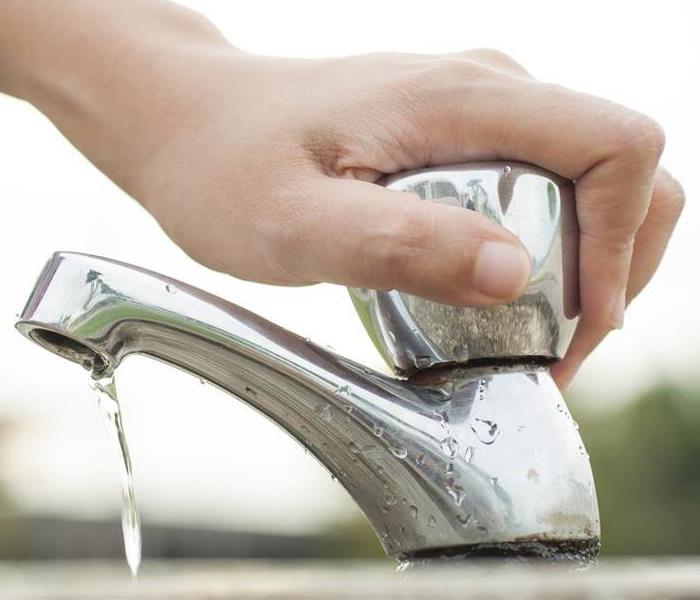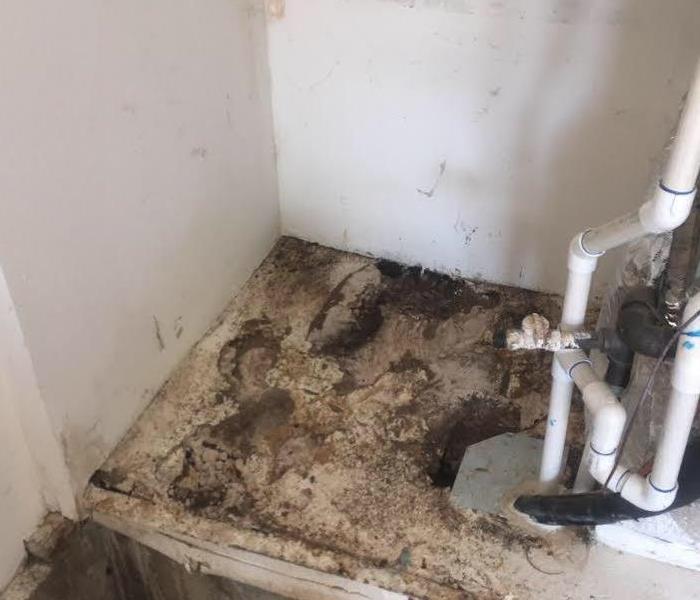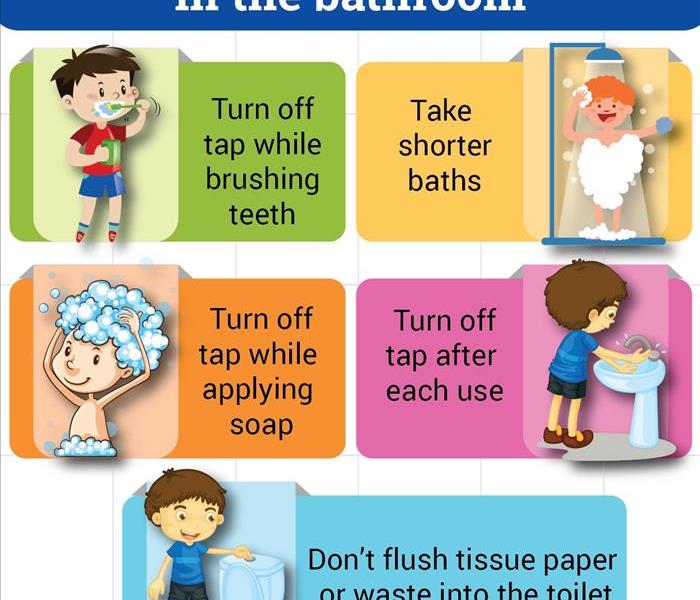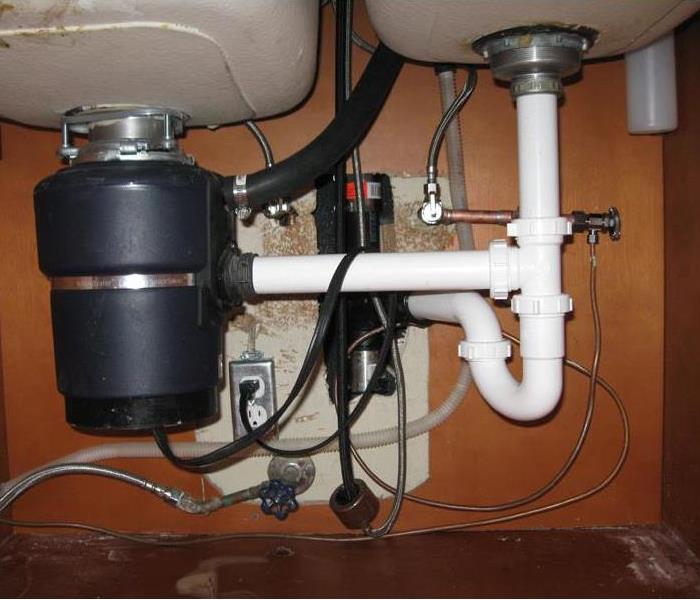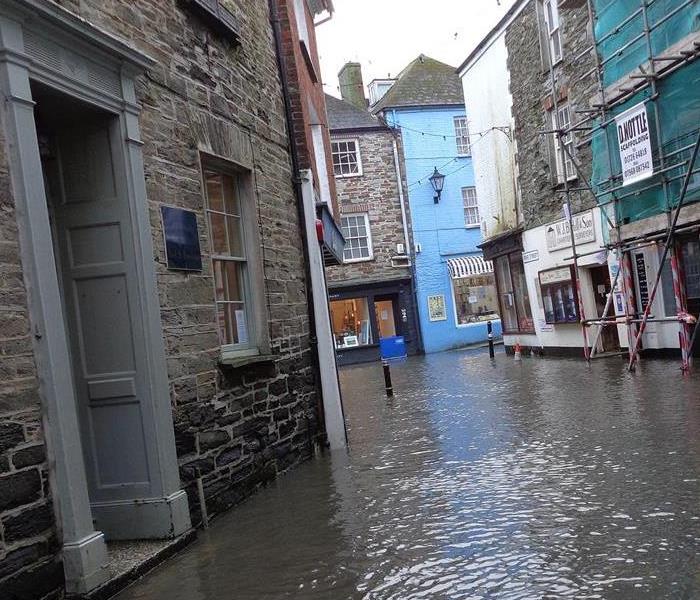Archived Water Damage Blog Posts
Forget to turn off the sink?
6/5/2024 (Permalink)
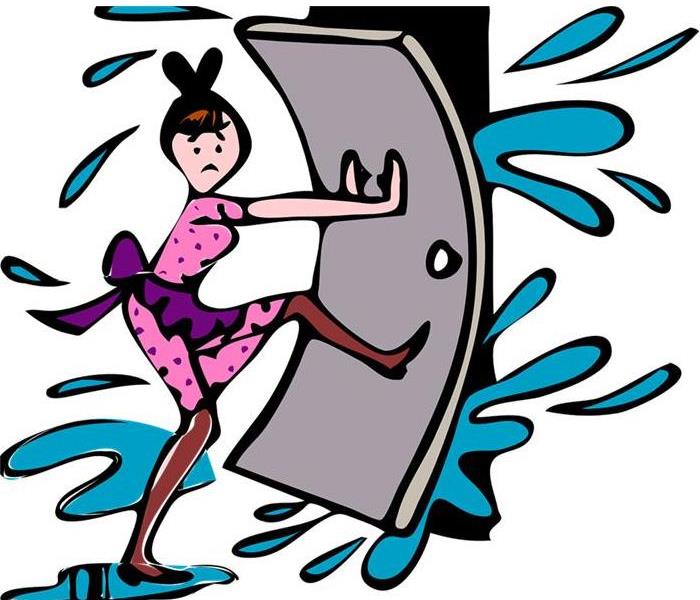 Forgetting to turn off a faucet can quickly lead to water damage!
Forgetting to turn off a faucet can quickly lead to water damage!
Have you left the sink running in your bathroom or thought you did? Do you know what unfortunate damage water causes to your home?
In Dallas, Oregon a family of four prepared for a restful night. Once everything was said and done, lights out and quiet fell over the house, no one realized the bathroom sink was left on. Morning came and routines began, but unfortunately the family was struck by a wet surprise. Their bathroom floor had standing water, and the carpet leading down the hallway was soggy, as well. In a panic the couple grabbed towels and a mop to soak up as much water as possible. Feeling defeated and lost, the couple decided to call SERVPRO Team McGinnis.
The phone call came in at 6:44am and we sent a team out immediately to inspect the damage. After assessing the damage, our team lead informed the homeowners that the water had gone into the drywall of the first floor. Water has the ability to seep into areas where it is not noticed by the naked eye.
After explaining the damage and locations, our team brought the equipment in to start the drying process. Our teams are highly trained in various drying techniques and chose the less damaging method. Rather than removing all the carpet to dry the water between the subfloor and carpet our team used a special drying method which floats the carpet allowing air to move under. Drying equipment is set in place and a thorough drying is started.
SERVPRO Team McGinnis takes into consideration the customer’s needs and concerns. With that, we create a plan that offers a timely process and professional services.
If you find yourself with possible water damage or have questions concerning water contact SERVPRO® today at 541-745-2097. Day or night, we have teams readily available to help with your disaster emergency!
Infra-Red for Water Damage?
5/3/2024 (Permalink)
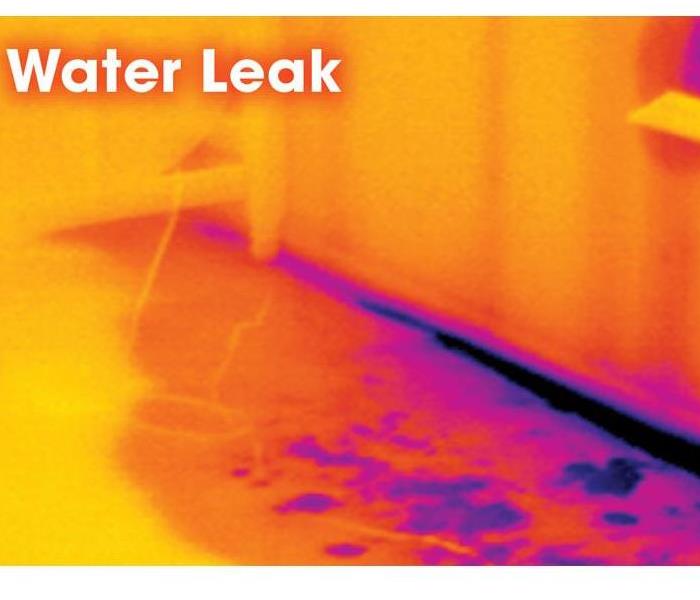 Infra-Red technology allows us to see the full extent of water damage, even when its not visible to the naked eye!
Infra-Red technology allows us to see the full extent of water damage, even when its not visible to the naked eye!
Infrared camera technology allows technicians to see what cannot be seen with the bare eye.
According to an article posted online by Flir Systems, Wilsonville - Oregon,
"An infrared camera is a non-contact device that detects infrared energy (heat) and converts it into an electronic signal, which is then processed to produce a thermal image on a video monitor and perform temperature calculations. Heat sensed by an infrared camera can be very precisely quantified, or measured, allowing you to not only monitor thermal performance, but also identify and evaluate the relative severity of heat-related problems."
Pretty neat technology, don’t you think? Now, we use it *slightly* differently than mentioned above. Water Restoration Technicians use the Infra-Red tech to search for water by looking for COOLER spots, which are indicative of the presence of water. It helps us to measure just how saturated the wall, the floor, or the door might be, which helps us better map out how best to help you and your emergency.
You see this is why use the infrared technology on all of our jobs because seeing is not always believing.
When you contact us for any water damage related service, our team will use the best technology we have to ensure your property is taking care of.
Call SERVPRO® Team McGinnis anytime day or night for help 541-745-2097.
Water DamageTips
2/22/2024 (Permalink)
 Some helpful tips if water damage does occur
Some helpful tips if water damage does occur
Emergency Water Damage Tips
After a storm passes, it is important to stay safe while waiting for help to arrive. Here are some tips to help prevent further damage after a storm, especially if your property has some water damage:
Shut Off Water Source
Shut off the water source if possible or contact a qualified party to stop the water source.
Turn Off Circuit Breakers
Turn off circuit breakers for wet areas of the business when access to the power distribution panel is safe from electrical shock.
Move Important Objects
Move any paintings, art, objects, computers, documents, or other sensitive valuables to a dry place.
Don't Enter Affected Areas
Do not enter affected areas if electrical outlets, switches, circuit breakers or electrical equipment are exposed to water. Always avoid electrical shock hazards!
Stay Away From Structural Damage
Stay away from visible structural damage. Close and rope off the affected area if possible.
Have Insurance Available
Have your insurance policy available and know the name of your insurance company and broker. Call SERVPRO® today at 541-745-2097! A professional will come out and assess damage and provide necessary mitigation services.
Winter storms can cause water damage!
2/20/2024 (Permalink)
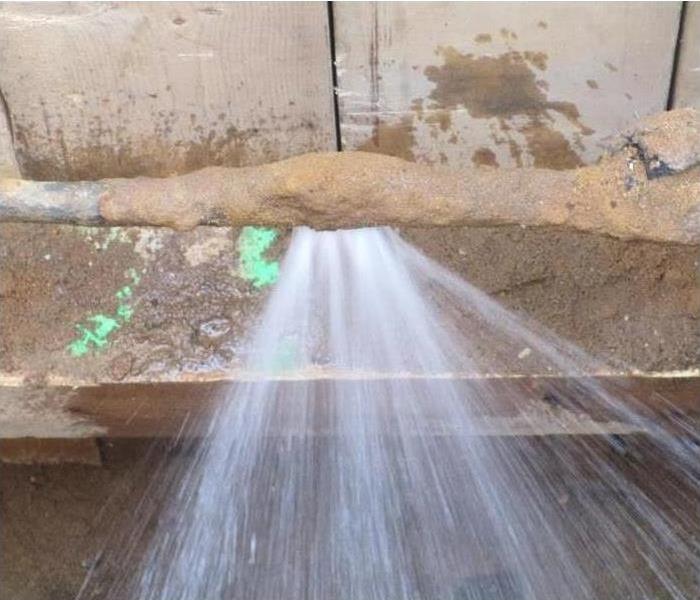 Freezing temperatures can cause pipes to break in your home!
Freezing temperatures can cause pipes to break in your home!
Wowzers!
Winter season really did a number on us here in the Pacific Northwest! From wind storms to ice storms we had an astonishing amount of falling trees on homes. This lead to massive water damage as the rain did not stop coming.
Freezing weather also caused frozen pipes.
If you have a pipe burst, SERVPRO® has trained professionals that can repair all the damages and have your home looking “Like it never even happened.” In the meantime, here are some tips to help prevent your pipes from freezing.
- If the crawl space access is inside the home, set a fan in the opening to blow warm air from the home to the foundation
- Leave the cabinet doors under the sink open to keep the pipes warm
- Caulk and seal around doors, windows and faucets
- Close all foundation vents that are near pipes
Call on the professionals at SERVPRO® today at (541).745.2097
Water Damage? Call us TODAY!
2/18/2024 (Permalink)
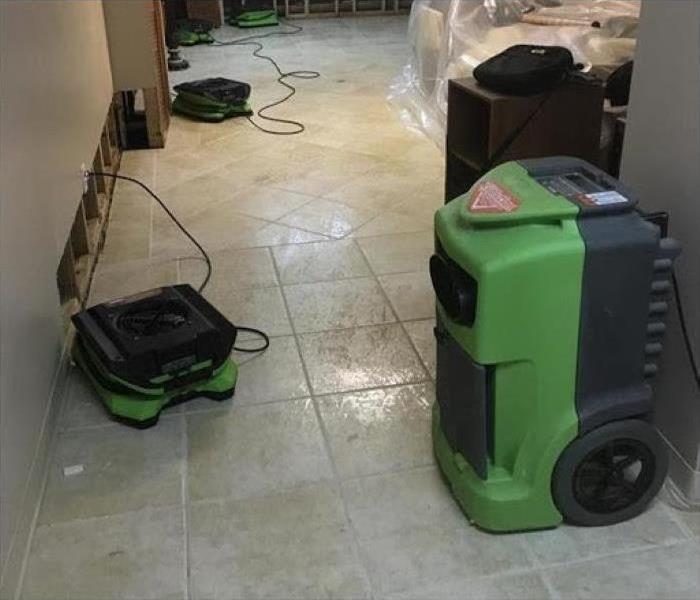 Water Damage? Do not hesitate to call SERVPRO®!
Water Damage? Do not hesitate to call SERVPRO®!
When it comes to water damage, SERVPRO® is the company to call! We take pride in restoring your property to its pre-damage condition. We take several steps to ensure no more damage occurs, and that the damage that has happened is taken care of as quickly as possible.
- Initial Emergency Contact: We are available 24 hours a day, if you have an emergency, call us right away!
- Inspection and Damage Assessment: When we arrive on scene, we will do a detailed inspection of the damage
- Moisture Extraction: If necessary, we will bring in pumps to extract excess water, and reduce drying time
- Dehumidifying and Drying: Once the excess water has been removed, equipment will be placed to speed up the drying time and help the moisture evaporate
- Cleaning and Repair: Items that can be saved will be professionally cleaned, anything non salvageable will be replaced or repaired
- Restoration: This is where we restore your home to its pre-damaged condition. This includes replacing flooring, drywall, trim, and painting.
Count on the Professionals at your local SERVPRO® franchise if you have water damage occur! Call us at 541-745-2097
Faster to Any Size Disaster
1/17/2024 (Permalink)
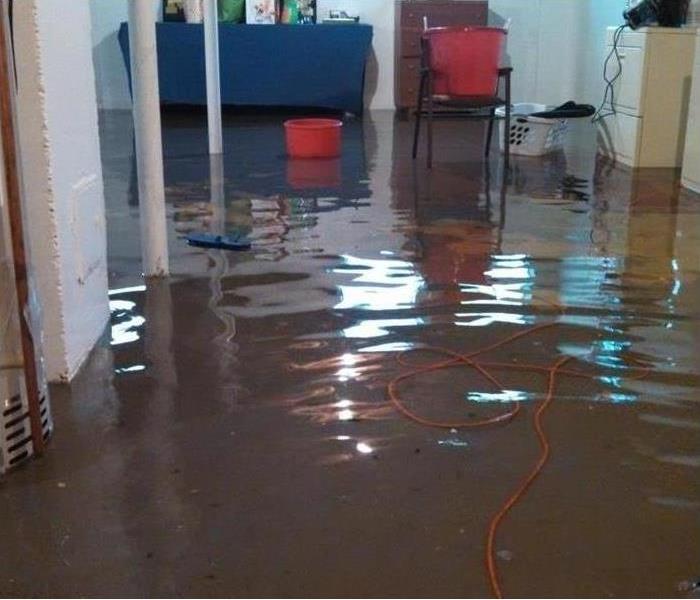 When water damage strikes, time is of the essence! Call SERVPRO® today
When water damage strikes, time is of the essence! Call SERVPRO® today
Flooding and water damage is very invasive. Water quickly spreads throughout your home and gets absorbed into floors, walls, furniture, and more. SERVPRO® arrives quickly and starts the water extraction process almost immediately. This immediate response helps to minimize the damage and the cleaning and restoration costs.
Water Damage Timeline
Within Minutes
- Water quickly spreads throughout your property, saturating everything in its path.
- Water is absorbed into walls, floors, upholstery, and belongings.
- Furniture finishes may bleed, causing permanent staining on carpets.
- Photographs, books, and other paper goods start to swell and warp.
Hours 1 - 24:
- Drywall begins to swell and break down.
- Metal surfaces begin to tarnish.
- Furniture begins to swell and crack.
- Dyes and inks from cloth and paper goods spread and stain.
- A musty odor appears.
48 Hours to 1 Week:
- Mold and mildew may grow and spread.
- Doors, windows, and studs swell and warp.
- Metal begins to rust and corrode.
- Furniture warps and shows signs of mold.
- Paint begins to blister.
- Wood flooring swells and warps.
- Serious biohazard contamination is possible.
More Than 1 Week:
- Restoration time and cost increase dramatically; replacing contaminated materials and structural rebuilding may be extensive.
- Structural safety, mold growth, and biohazard contaminants pose serious risks to occupants.
SERVPRO® specializes in the cleanup and restoration of residential and commercial property after a fire, smoke or water damage event. Our staff is highly trained in property damage restoration. From initial and ongoing training at SERVPRO Corporate training facility to regular IICRC-industry certification, rest assured our staff is equipped with the knowledge to restore your property. Need Emergency Service? Call us today at 541-745-2097
Water Damage in Your Home
6/8/2023 (Permalink)
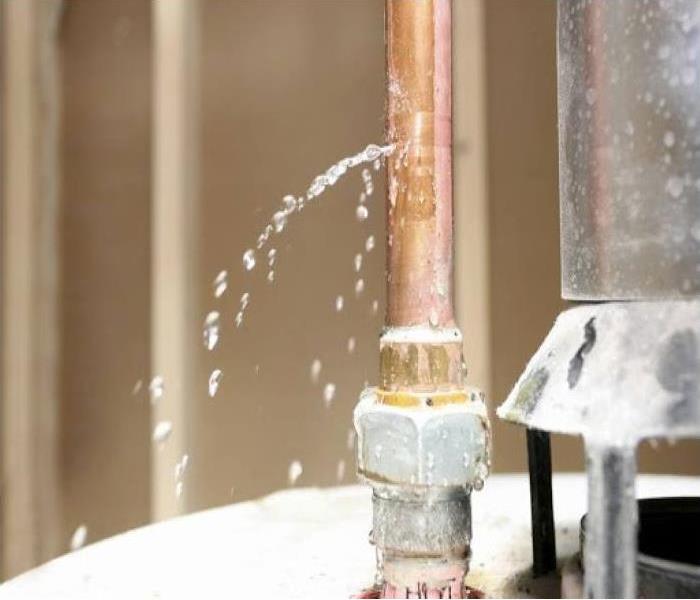 even a small leak can lead to big disasters
even a small leak can lead to big disasters
Coming home to a broken pipe under your sink and a flooded kitchen or bathroom floor? Discover your upstairs shower has been leaking for a while after it starts raining downstairs?? Drying your home after a water loss is important, and SERVPRO is here to help you every step of the way!
The top things 3 things to remember when dealing with a water loss are:
- Know what kind of water loss it was: Clean water (CAT 1) = Pipe or rain water.
Gray water (CAT 2) = Toilet water, sink pipe.
Black Water (CAT 3) = Sewer water.
*CAT 2 and 3 are the most harmful to your family. The water is contaminated and can cause greater damage than mold. Seek help from a Professional if you suspect the water came from a contaminated source*
- Make sure you investigate all the damage.
- Establish proper air flow, and keep windows closed when drying.
- CALL SERVPRO as soon as you notice water damage in your home!
Mold can grow quickly if the moisture is not addressed as soon as possible. SERVPRO® can help with drying out your home, we have the equipment to dry your home quickly and repair any damage. If your home is experiencing water damage, SERVPRO can fix it.
Addressing a Toilet Leak: Tips and Advice from SERVPRO
5/4/2023 (Permalink)
A toilet leak is a common problem that can cause a significant amount of damage to your home if left unaddressed. Not only can it create a mess and unpleasant odors, but it can also lead to mold growth and structural damage. Fortunately, there are steps you can take to identify and address a toilet leak, and SERVPRO is here to help.
The first step in addressing a toilet leak is identifying that you have one. Some common signs of a toilet leak include:
Water around the base of the toilet: If you notice water pooling around the base of your toilet, it is a clear indication that there is a leak.
Damp or discolored flooring: If the flooring around your toilet is damp or discolored, it is a sign that water has been seeping into the area.
A musty odor: A musty odor coming from your bathroom is a sign that there is moisture present, which could be caused by a toilet leak.
An increase in your water bill: If you notice an unexpected increase in your water bill, it could be due to a leaky toilet.
If you suspect that you have a toilet leak, it is important to address it promptly to minimize damage to your home. Here are some steps you can take:
Turn off the water supply: The first step in addressing a toilet leak is to turn off the water supply to the toilet. This will help prevent further damage and give you time to address the issue.
Identify the source of the leak: Once the water supply is turned off, identify the source of the leak. It could be a damaged wax ring, a cracked toilet bowl, or a faulty fill valve.
Repair or replace the damaged parts: Depending on the source of the leak, you may need to repair or replace the damaged parts. If you are not comfortable doing this yourself, it is best to hire a professional plumber.
Clean up the water: If there is water on the floor, use towels or a wet/dry vacuum to clean it up. It is important to thoroughly dry the area to prevent mold growth.
Monitor the area: After you have addressed the toilet leak, monitor the area for any signs of further damage. If you notice any issues, such as mold growth or water damage, contact SERVPRO for professional cleanup and restoration services.
Preventing a toilet leak is easier than dealing with one. Here are some tips to help you prevent a toilet leak in your home:
Regularly inspect your toilet: Inspect your toilet regularly for signs of wear and tear, such as cracks or leaks. If you notice any issues, address them promptly.
Avoid flushing non-flushable items: Only flush toilet paper and human waste down the toilet. Avoid flushing items like baby wipes, feminine hygiene products, and cotton swabs, as they can clog your pipes and cause leaks.
Replace old toilet parts: Over time, the parts in your toilet can wear out and become damaged, leading to leaks. Consider replacing old parts, such as the fill valve or flapper, before they cause a problem.
Hire a professional plumber: If you are not comfortable inspecting or repairing your toilet, hire a professional plumber to do the job. They can help identify and address any issues before they cause damage to your home.
If you suspect that you have a toilet leak, it is important to address it promptly to minimize damage. With these tips and the help of SERVPRO, you can identify, address, and prevent toilet leaks.
Water Damage can Displace a Family!
2/22/2023 (Permalink)
One of the things we at SERVPRO have seen repeatedly is a water loss displacing a family. This can be due to several factors, but it is always extremely difficult on the family to be displaced from their home while dealing with a traumatic water loss.
One of the main reasons homeowners have to find temporary housing outside of their homes is due to no bathroom being usable in the current house due to a water loss. When a water loss happens in a 1-bathroom home and the flooring and the toilet need to be removed, it is cause for displacement of the homeowners due to the lack of usable facilities at the home.
Another reason that homeowners are displaced is when a kitchen water loss happens, sometimes the cabinets, stove, fridge, and flooring need to be removed in order to effectively dry the area. A house with no usable kitchen is a common cause of customers finding temporary housing outside of their home.
Unsafe living environments. Unsafe living environments can mean a few different things, the first and most common is mold infestation. Homeowners are sometimes temporarily displaced due to mold that needs to be remediated that has been uncovered/discovered during a water loss. Sometimes the extent of the mold infestation warrants the homeowners to relocate until the mold can be safely and effectively remediated.
Inconvenience. Sometimes homeowners relocate due to the large inconvenience that comes with a water loss. Sometimes flooring, ceiling, walls, and personal belongings are affected due to a water loss. Homeowners may not want to deal with the noises of dehumidifiers, air movers, and the noise that comes with the demo and reconstruction needed at times during a water job, and therefor opt to relocate until the water loss and reconstruction has been finished.
Odor in the home from the water loss. Sometimes water losses can cause odors to emit from the materials that they affect. Sometimes water losses are also from drain lines or sewer lines that cause a strong odor to be present until they are cleaned and dried. Homeowners are often displaced temporarily due to odors.
So the reasons vary for homeowners to vacate during a water loss, but it is much more frequent than you would expect. Depending on the location and the extent of a water damage, homeowners can be displaced for days or months at a time.
Flooding Caused by Storm Drains!
2/22/2023 (Permalink)
When the rain gets heavy, the standing water can build where it shouldn't!
We have had record calls from homeowners and businesses this past year about standing water in their parking lots, and overflowed storm drains.
Many times this can happen due to debris being built up in the drain filter. Cleaning it out is hard physical labor, but regularly necessary.
Also, sometimes storm drains simply cannot keep up with heavy rainfalls and downpours. If you notice a storm drain in your town that is flooded and not draining properly, you can reach out to your local public works department at the city and report the problem.
If the storm drain is located on your private property you are responsible for servicing the storm drain yourself. Most likely it is a build up of debris in the upper portion of the drain filter, but sometimes it is a failure of the line that runs undergroud. the later is a much more significant cost to fix.
Plumbers have specialty equipment to clear drains. SERVPRO has provided such services, but if the problem is more than a clogged drain filter, a plumber and excavator company will most likely be needed.
You can check your storm drains with a flashlight periodically when they are free of standing water and see if you can spy any clogging or build-up of leaves and rubbish that is preventing the drain from working optimally.
SERVPRO unclogged our own parking lot storm drain this past year, it was due to leaves and branches and dirt build-up. Often times it can clog very suddenly. So best to inspect seasonally if possible.
Water Damage to a Kitchen Can be Costly!
2/22/2023 (Permalink)
When we think about the kitchen in a home we think about cooking, food, dishes, and appliances.
Often these days we also think about the finishes in the kitchen. It’s fairly common for counters to be made of Quartz, Marble, or Granite. Also, cabinets have become more costly in the last decade, and even more costly in the last year with the lumber prices skyrocketing. Often the thing people splurge on is the appliances in a kitchen, which can run anywhere from several hundred dollars to several thousand dollars.
The average cost of a kitchen renovation today in America is $22,184 dollars. Or roughly $150 dollars per square foot! This makes the kitchen the most expensive square footage in your home. With bathrooms only coming in at $18,000 (Master Bath, much less for guest bath).
So taking all the costs into account, it’s easy to understand how a customer can be very upset when we arrive onsite at a water loss in a kitchen. Many times water losses in kitchens means we have to take out all flooring and cabinets to dry the underpayment (and sometimes subfloor!) Most of the time water losses in kitchens are due to dishwashers, refrigerators, insta-hot devices, and freezers. Sometimes kitchen losses are due to an adjoining laundry room having a water loss from the washer.
This is why our SERVPRO technicians will try and dry wooden floors in place if possible. It saves the homeowner time without a kitchen if it can be achieved, and also many times saves the customer from having to file a costly claim with their homeowner's insurance.
If the water is contaminated, that is another situation entirely, and SERVPRO always recommends that the flooring be removed and replaced if saturated beneath the surface area.
Condensation from Water
1/18/2023 (Permalink)
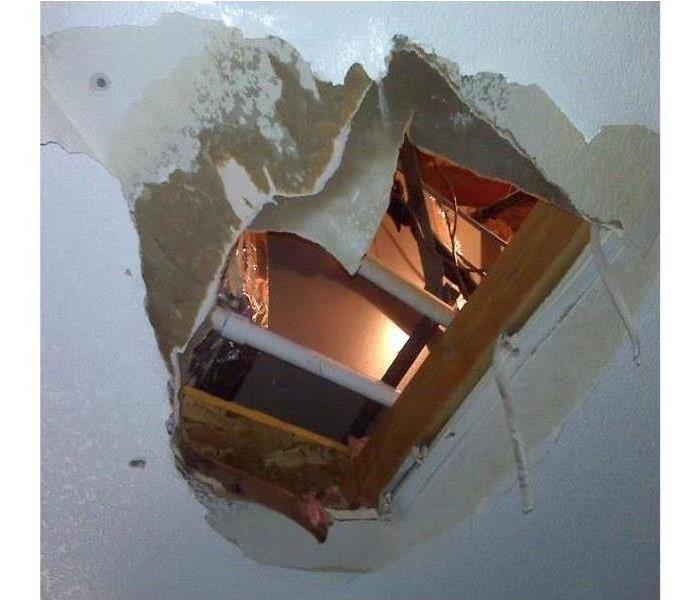 Condensation from a AC Unit can Cause damage!
Condensation from a AC Unit can Cause damage!
Water- ekkk!
The discovery of wet feet while strolling through your home is always a unwelcomed shock. Typically the kitchen, bathroom or wash room is where you will find this.
As it starts to warm up, many are turning on their air conditioning units. They do not think that this could be a source of a water loss. However it is, the water condensation from these systems can wreak havoc and cause a major water loss. We here at SERVPRO see this annually.
Here are some tips to draining your air conditioner.
1. Turn off the power to your HVAC system at the thermostat and at the breaker.
2. If you have an indoor air handler in your attic or utility closet, you'll need to find the condensate pan. This is usually located directly under the unit. It may also be covered by a removable access panel.
3. If you see standing water in the drain pan, your drain line is probably clogged. Use a handheld or shop vacuum to remove the moisture. You can also use rags to soak up the water. At this point, you can clean the drain pan with soap.
4. Generally, clogged drains can be cleared with suction. If you have a shop vacuum, use it to pull the clog through the drain opening, which is located outside your house near the foundation. Place your hand around the pipe to improve suction and allow the vacuum to run for a minute. Then, check the vacuum canister to see if the clog was successfully removed.
5. Next, you'll need to identify the access point on the drain line. Usually, the drain will have a T-shaped vent with a PVC cover. Remove the cover and inspect the drain. Use this port to flush the drain with distilled vinegar. If you don't like the odor, you can use peroxide to gently bubble away the remaining debris. Alternately, you can use hot water and a drop of dish liquid.
6. Allow the solution to sit for 30 minutes. Complete the cleaning by flushing the pipe with water. Have a helper watch the pipe outside and tell you if the water is running freely.
What are secondary damages in Water Restoration?
1/17/2023 (Permalink)
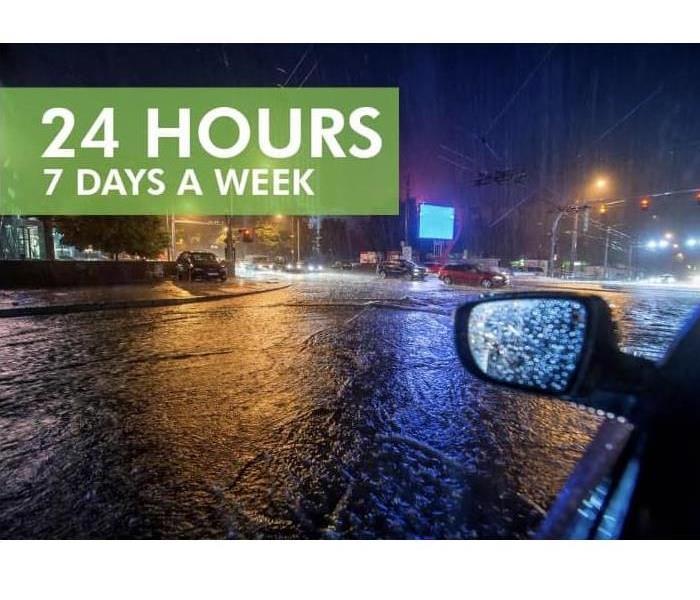 Here to Help at any Hour!
Here to Help at any Hour!
What are secondary damages in Water Restoration?
Water damages that are left unmitigated quickly develop secondary damages. The most common secondary damage is mold growth. Mold growth can begin as soon as 3 days following a water loss. It’s extremely crucial for homeowners and business owners to get water damages properly mitigated as soon as they happen, because most insurance policies have zero mold coverage/secondary damages coverage.
Another secondary damage is dry rot. Dry rot is what happens when spores in the air combine with wood that is holding more than 20% moisture, so it’s most likely when the structural integrity of the wood is compromised due to prolonged exposure to water. Dry rot can affect the foundation of your home and present very expensive repairs.
Unmitigated water damage also can encourage rodent infestations. Many times, even in brand new buildings, one small supply line leak can cause mice to occupy the structure. Rodents follow water and will go where there is a steady supply. Rodents can also more easily chew through affected drywall and wood.
Corrosion is also a clear sign that a water damage has been going on longer than it should have. With metals like pipes and nails, if there is rust or corrosion buildup that is an indication that coverage may not be a guarantee on your insurance claim.
Bottom line, if your home or business suffers a water damage, it’s important that you take immediate action and call a restoration company like SERVPRO of Salem West to mitigate the damage and prevent further issues. It may be an expense to mitigate a water loss, but it’s far more affordable than paying for secondary damages!!
“How Soon Can You Get Here?”
6/9/2022 (Permalink)
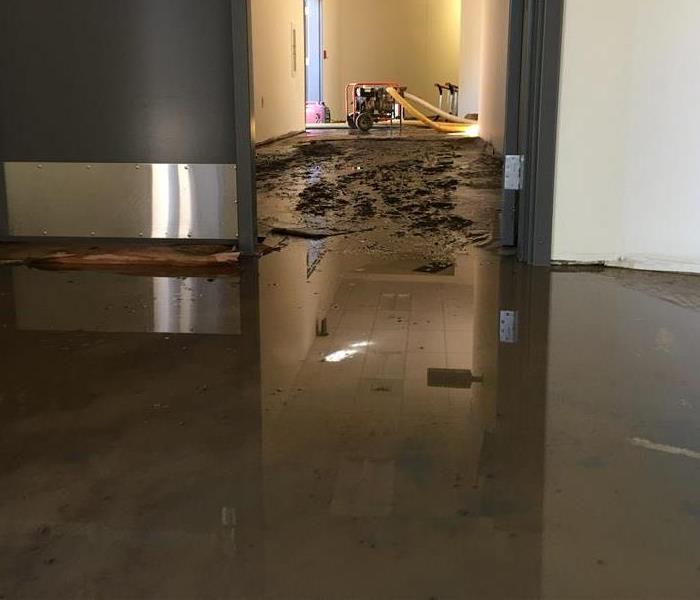 During a disaster, SERVPRO realizes that response time is paramount at starting the job off right!
During a disaster, SERVPRO realizes that response time is paramount at starting the job off right!
How fast can you get here?
That is one of the most popular questions we get asked as a emergency response company. Often the customer who is calling is distraught, in a panic, and the most important thing that they want to know is how fast we can be there to help them in their time of need.
SERVPRO has a reputation for being the fastest restoration company in the industry. We have set the bar higher than any other restoration company nationwide when it comes to responding to disasters and emergencies.
How fast we respond does have something to do with our location in relation to theirs. Also the availability of the nearest technician and equipment available. But all of these factors get added in to the emergency response timeline that we give the customer.
Let’s face it, when you are standing in the middle of your living room and it’s raining indoors due to an overflowed tub upstairs or a broken pipe, you aren’t worried about much else but getting your home or business stabilized as soon as possible.
So if you need fast response and trained professionals in hurry, call SERVPRO of Benton & Linn Counties. We can get you back to preloss condition, and make it "Like it never even happened."
When Water Affects Commercial Properties
5/13/2022 (Permalink)
 Helping Commercial Buildings Through The Water Loss Process Is One Of Our Specialties.
Helping Commercial Buildings Through The Water Loss Process Is One Of Our Specialties.
Businesses in the Willamette Valley have been through a lot over the last couple of years. We lost many small businesses here in Oregon due to the pandemic, and the forced closures and measures enforced and constantly updated on what it took to keep businesses open. Through this, we still responded to many water losses in commercial structures. Many caused by pipes, toilets, or even the drains in the floors.
Working with small businesses is a huge source of pride for SERVPRO. Helping a small business get back on its feet and reopen its doors after a water loss is a thrilling and fulfilling moment. At SERVPRO we understand the importance of time lost when a business cannot keep its doors open. Time is of the essence, and it helps that we are a 24 hour company with nationwide resources.
Upon arrival to a water loss at a business, one of the first things a SERVPRO Technician does it determine any safety hazards. They may ask the following questions;
-Is the water clean water? Or is it contaminated? This determines how much PPE our technicians will be required to wear.
-Has the electricity been turned off to the structure that is affected? If not, where is the electric shutoff?
-Has the source of the water been fixed? Or is the water still running? If the water is still running, where is the water shutoff?
-All water losses have slip hazards, our technicians need to be sure that our team is equipped with the proper foot attire. Flip-Flops are not appropriate.
-Each one of our technicians will ask the question “How can I stabilize this loss best?” The stabilization of a loss is what it takes to stop any further water damage to the area. In most cases this starts with the removal/extraction of any surplus water from affected materials. It can also include the removal of materials that will not properly dry (carpet pad, insulation, warped laminate flooring, warped trim, etc.).
All of these questions set up a commercial loss response for being successful. Time is of the essence, so our SERVPRO Technician will want to start work right away after addressing any concerns the business owner may have.
Remember calling SERVPRO is the best choice you can make if your business suffers a water loss. We are truly “Faster to any Disaster!”
Ice, Fire, Water!
2/21/2022 (Permalink)
 3 Story Water Loss!
3 Story Water Loss!
Last year we experienced a water loss like no other. It was originally a fire call that came in during an ice storm. The electrical panel had short circuited due to freezing and caught fire. The fire was limited to one room, however set off the sprinkler system for a three story medical facility. With the sprinklers going off and having a PSI of 3400 gallons a minute we had a lot of water to extract and a building to dry out.
This was; big scale drying including large generators, ducting and a 50 plus crew to remove contents, flooring and complete flood cuts for proper drying process. This job required many dehumidifiers, fans and a very detailed scope of work to insure no secondary issues would occur.
When you experience a commercial water loss call SERVPRO!
Water Damage Could Happen at Anytime- Day or Night!
2/21/2022 (Permalink)
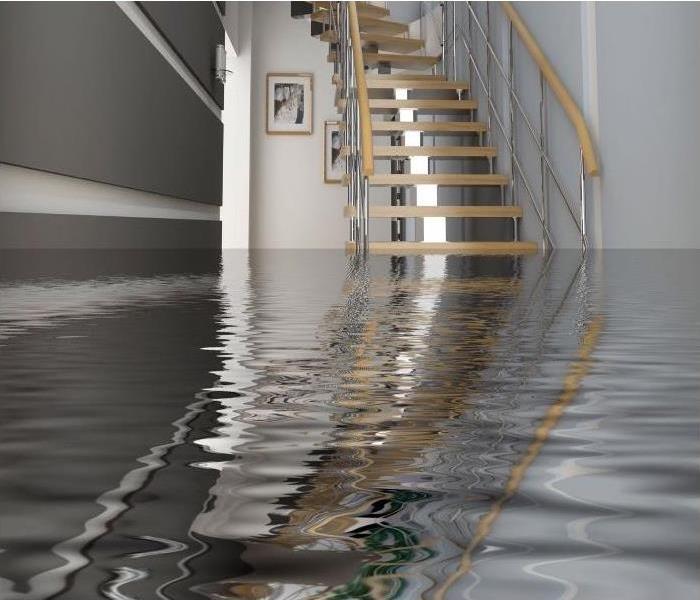 Standing Water an Issue?
Standing Water an Issue?
Did you know we have seasons here at SERVPRO when it comes to water damage?
During the winter we often see a large influx of water losses due to frozen pipes, flooding and trees on houses allowing for water to inter the home, roof damage and flooded basements.
During the summer months we tend to see air conditioning unit water losses and the remainder of the year we attend to many dishwasher leaks, refrigerator, washer machines, hot water leaks and over flowed tubs.
Water damage is often sudden and accidental. Drying processes must start as soon as possible. This will keep from having secondary issues arising such as mold growth.
We are always here to help if you have anyone of of these water losses. WE make it "Like it never even happened."
Do you have our Number on Speed Dial?
2/21/2022 (Permalink)
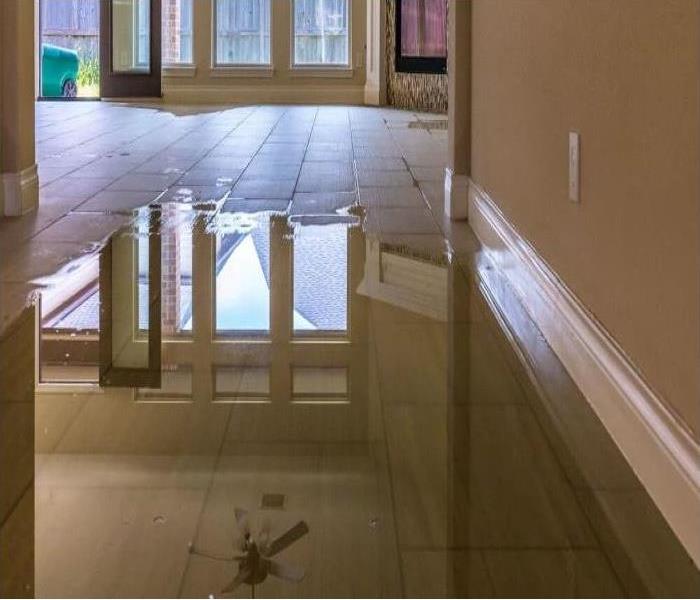 Wet feet?
Wet feet?
Unfortunately, water leaks and floods can occur at any time of year, no matter where you live. A variety of common causes can be blamed for water leaks and damage to homes. These include storms, plumbing issues, clogged drains, or malfunctioning appliances. No one wants to be surprised by, wake up or come home to wet floors or a flooded basement.
Do not put off restoring water damage. Mold growth for example, can become a severe issue in as little as 24 hours, while sewage leaks are a health hazard that needs to be addressed immediately. The sooner any kind of water damage is taken care of, the better and less costly it will be.
Call us here at SERVPRO if you experience a water loss. We work with you, your adjusters and can inform you of the necessary steps to protect your property from further damage.
Put our number on your speed dial list!
What exactly is SERVPRO doing for my Water Loss?
1/18/2022 (Permalink)
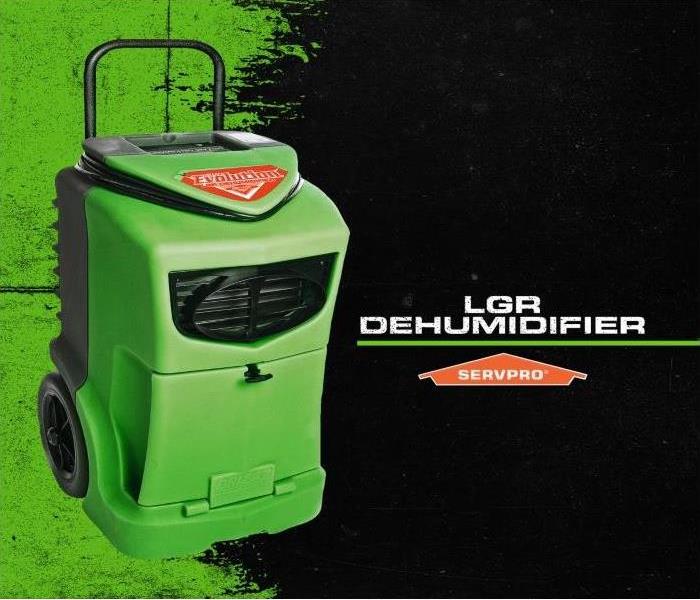 Top of the Line Equipment to Protect your Home!
Top of the Line Equipment to Protect your Home!
Have you discovered water in your home? Do you need a professional to explain what to do next? if so call us.
After the water removal step, your floors and walls may look dry at first glance, but they are still wet to the touch. Most building materials, like drywall and wood, are porous and will retain significant water. The retained water will cause these materials to warp, swell, or break down and can also cause mold damage.
What to do: Drying / Dehumidification
Our trained technicians will manipulate temperature and relative humidity to remove the remaining moisture. We use specialized equipment, including industrial air movers and dehumidifiers, to remove water retained by building materials and other hard-to-access moisture. We’ll carefully monitor the progress using moisture meters until the materials return to acceptable drying goals.
- Use Dehumidification Equipment
- Use Monitoring Equipment to Track Progress
Protecting your home. Possible Water Issues.
6/10/2021 (Permalink)
 Regularly Check Your Venting Systems for Condensation
Regularly Check Your Venting Systems for Condensation
Being a homeowner can be one of the most rewarding, but also one of the most stressful things
in life. Water damage and leaks is one of the most common things you will face as a
homeowner, and most of those leaks come from our appliances. SERVPRO has some tips on
how to keep your home safe from water damage.
? Check behind your appliances at least once a year
? Check hoses for small pinhole leaks
? Consider installing an automatic shutoff valve
? Check that valves are tightened properly
? Make sure hoses are not kinked, and leave ample space between the valve and
appliance
- Check Air conditioners, they give off condensation. Assure there is proper venting.
Routine Inspections are a great way to keep your home safe from water damages. A small leak
can lead to big damage! Call your local SERVPRO today! We’ve got all the tools, and the
trained professionals to keep your home safe!
Water Condensation Not Discovered Could Wreak Havoc!
5/18/2021 (Permalink)
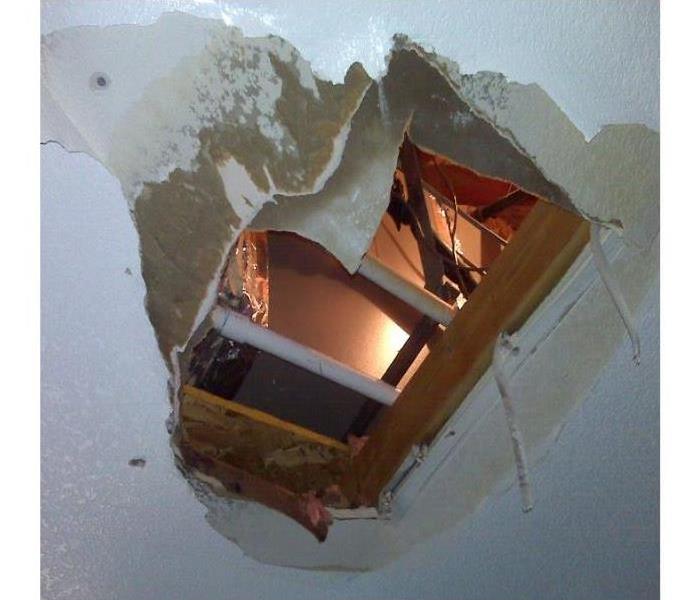 Water Condensation From Air Condition Damage!
Water Condensation From Air Condition Damage!
Water- ekkk!
The discovery of wet feet while strolling through your home is always a unwelcomed shock. Typically the kitchen, bathroom or wash room is where you will find this.
As it starts to warm up, many are turning on their air conditioning units. They do not think that this could be a source of a water loss. However it is, the water condensation from these systems can wreak havoc and cause a major water loss. We here at SERVPRO see this annually.
Here are some tips to draining your air conditioner.
1. Turn off the power to your HVAC system at the thermostat and at the breaker.
2. If you have an indoor air handler in your attic or utility closet, you'll need to find the condensate pan. This is usually located directly under the unit. It may also be covered by a removable access panel.
3. If you see standing water in the drain pan, your drain line is probably clogged. Use a handheld or shop vacuum to remove the moisture. You can also use rags to soak up the water. At this point, you can clean the drain pan with soap.
4. Generally, clogged drains can be cleared with suction. If you have a shop vacuum, use it to pull the clog through the drain opening, which is located outside your house near the foundation. Place your hand around the pipe to improve suction and allow the vacuum to run for a minute. Then, check the vacuum canister to see if the clog was successfully removed.
5. Next, you'll need to identify the access point on the drain line. Usually, the drain will have a T-shaped vent with a PVC cover. Remove the cover and inspect the drain. Use this port to flush the drain with distilled vinegar. If you don't like the odor, you can use peroxide to gently bubble away the remaining debris. Alternately, you can use hot water and a drop of dish liquid.
6. Allow the solution to sit for 30 minutes. Complete the cleaning by flushing the pipe with water. Have a helper watch the pipe outside and tell you if the water is running freely.
Have You Looked Under Your Sink?
3/2/2021 (Permalink)
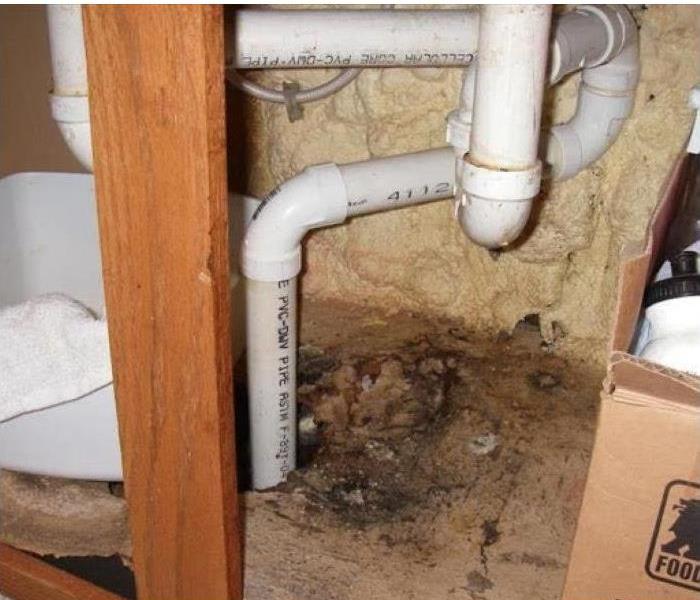 Be sure to check your pipes!
Be sure to check your pipes!
Have You Looked Under Your Sink?
One of the most common leaks found is right under your sink. Most homeowners never think to look there, and the leak goes unnoticed until it causes major damage!
- Make sure you check once a month under you sink for leaks.
- Don't keep a lot of stuff under the sink, that will make it harder to notice a leak
- Line your cupboard with a cupboard liner, so that it can be protected from moisture.
- When the weather is below freezing leave your cupboard open to allow heat in to keep the pipes warm
- Do moisture checks once a month to make sure the wood/plywood is not wet
Not looking for potential leaks could leak to water damage and mold issues.
Suspect a leak somewhere in your home? Call SERVPRO today!
There are Many Ways one can Experience a Water Loss
3/2/2021 (Permalink)
What could be causing damage in my home?
There are many things that can go wrong while being a homeowner, and some of those problems are things we never see.
A Leaky Basement
Leaky Plumbing
Damaged Drywall
Roof Leaks
Gutters Fail
Sump Pump Failure
Pipe Burst
Over flowed bath tub
Malfunctioning Refrigerator, Dishwasher, Washer Machine
Water back up
Water Heater Failure
Accidents
As a SERVPRO Franchise, we have all the proper tools and trained professionals to help with any of these issues. Unseen water damage that goes unfixed for long periods of time can lead to even more problems, like mold and structural issues. If you suspect you have any leaks, or see signs of mold or water damage, call us today!
SERVPRO of Benton & Linn County - (541).745.2097
Winter Storms Cause an Array of Water Damage!
3/2/2021 (Permalink)
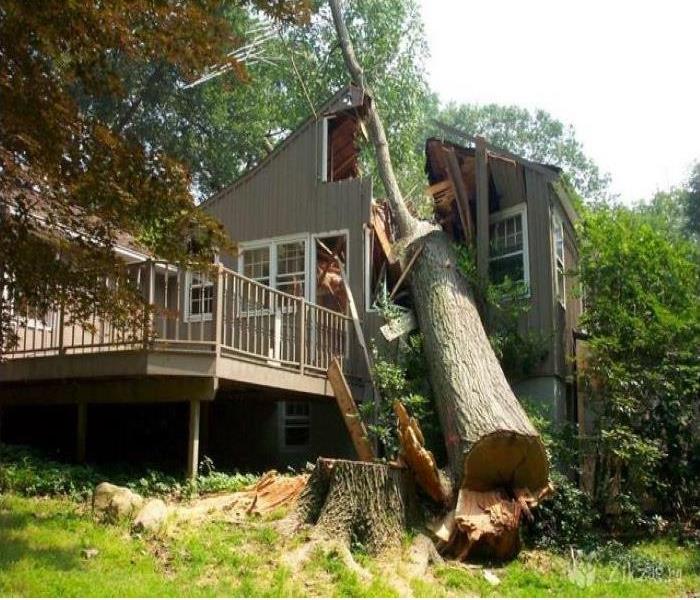 Downed Trees leads to Water Damage!
Downed Trees leads to Water Damage!
Wowzers!
Winter season really did a number on us here in the Pacific Northwest! From wind storms to ice storms we had an astonishing amount of falling trees on homes. This lead to massive water damage as the rain did not stop coming.
Freezing weather also caused frozen pipes.
If you have a pipe burst, SERVPRO has trained professionals that can repair all the damages and have your home looking “Like it never even happened.” In the meantime, here are some tips to help prevent your pipes from freezing.
- If the crawl space access is inside the home, set a fan in the opening to blow warm air from the home to the foundation
- Leave the cabinet doors under the sink open to keep the pipes warm
- Caulk and seal around doors, windows and faucets
- Close all foundation vents that are near pipes
SERVPRO Benton & Linn County - (541).745.2097
Sprung a Leak?
1/12/2021 (Permalink)
 When you have a unexpected surprise, call the professionals!
When you have a unexpected surprise, call the professionals!
When it comes to your home and family, even the smallest issue can cause a huge disruption. When small leaks begin in areas you can’t see, it can lead to harmful mold, rot and damage to not only your home, but your families health as well. SERVPRO is a 24-hour emergency response franchise that specializes in Fire & Water - Cleanup & Restoration. We ensure we can find the source of the leak, no matter where it hides! Once the leak has been fixed, our trained professionals can repair any of the damages that may have been caused by the leak, and have your home looking “Like it never even happened.”
Do:
- Shut off the source of the water if possible
- Turn off circuit breakers for wet areas of the building
- Remove as much excess water as possible by mopping and blotting
- Wipe excess water from wood furniture
- Remove any materials/ objects that may be sensitive to moisture(paintings, computers, documents)
Don’t:
- Enter rooms with standing water where electrical shock hazards may be present
- Leave books, newspapers, or magazines on wet carpet (may cause staining)
- Use your household vacuum to remove water
- Use TV’s or other appliances while standing on wet surfaces
- Turn on ceiling fixtures if the ceiling is wet (there may be damage to the electrical)
How Do I Remove Water from Different Flooring Types?
6/15/2020 (Permalink)
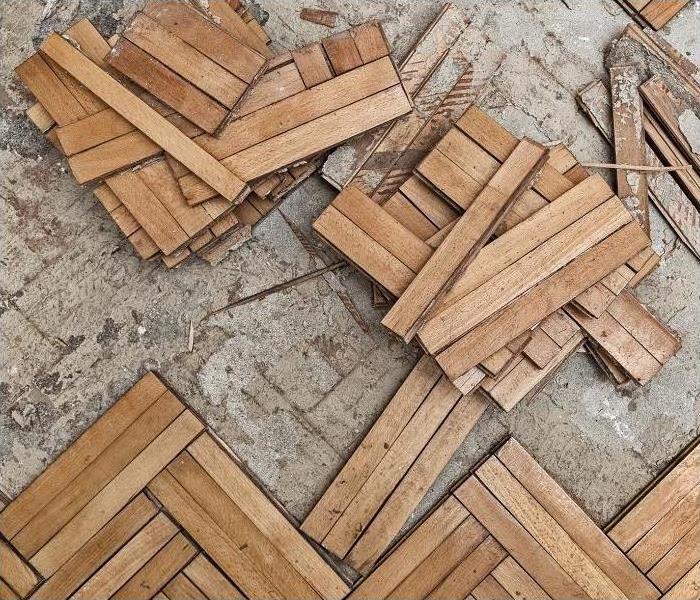 Water quickly damages flooring materials. Depending upon the scope of damage, sometimes the floor can be salvaged.
Water quickly damages flooring materials. Depending upon the scope of damage, sometimes the floor can be salvaged.
SERVPRO has the Knowledge for Flooring Restoration After Portsmouth Water Loss Events
Your home has many different flooring types, and our SERVPRO professionals have different tools and equipment that can help to restore these after water losses. Many materials compose the construction of your home's flooring, walls, and ceiling systems. Different strategies are necessary to remove water and moisture from these structural elements because so many materials make up your home. Our team of professionals has extensive training and experience to provide the ideal approach for whatever wet surface we encounter.
Recognizing what tools are best for actions like water removal in your homes gets determined during the initial evaluation and damage assessment. Scoping the job is a process where our project manager and crew chief work with the customer to identify preloss conditions and pre-existing conditions so that we can return the property to its original state as efficiently and cost-effectively as possible.
Can You Remove Water from Carpeting?
In areas like your living room and bedrooms, carpeting is one of the typical flooring types encountered in area homes. When migrating water reaches the fibers of carpeted floors, this moisture can get quickly absorbed. It is critical to remove water from carpeting as soon as possible so that moisture does not penetrate the padding and, eventually, the subflooring material. When reconstruction is necessary, the cost of recovery amplifies. Some of the water removal tools and practices for carpeted floors include:
- Carpet Wands – Wands are fierce attachments for wet vacuums and extractors that can pull water from the surface layer and the padding of carpeted floors. These tools are wise choices when the padding is getting replaced.
- Weighted Extractors – Stand on and ride on extraction tools can force the surface layer of carpeting and the padding together against the subflooring. This action forces moisture to the surface for an onboard vacuum to remove.
- Floating Practices – By placing a centrifugal air mover between the top and padding layers of carpeted floors, we can dry both of these materials simultaneously in a floating process. This style is risky as it could cause de-lamination from the primary and secondary backing of the carpet.
Is Wood Flooring Salvageable After Water Damage?
The composition of wood surfaces, especially flooring, makes it a sensitive material to standing surface water. Absorption can happen quickly, which can be disastrous if the water does not get removed quickly. Within as little as 48 hours, saturation can reach the point where it begins to warp and distort wood planks, leaving no option but removal and replacement. Some of the approaches for drying wood floors include:
- Air movers
- Drying Mat System
- Tenting
Does Standing Water Damage Tile?
Many homeowners believe that tile flooring is impenetrable, even to standing water. While it is far more difficult for water to breach even the grout joints between floor tile, a small opening or breach in this water-tight seal can allow penetration to the mortar bed and subflooring material. The water beneath tiling can be destructive and hard to detect initially. Our SERVPRO team can address potential concerns with a simple three-step formula for removing water:
- Extraction – We cannot determine the damage that standing water has done in areas like the kitchen or bathroom until we have removed it. There are multiple extractors, but often wet vacuums and electric submersible pumps are the common implements.
- Surface Moisture Meter – With pooling water addressed, our technicians can work to determine the damage to tile flooring and other exposed materials. Finding moisture pockets often falls to a surface moisture meter device or probing tool to identify if damp areas exist beneath the top layer.
- Drying Mats – If pockets of moisture get detected with thermal imagery and surface meters, we can lay drying mats to slowly draw moisture from the mortar bed and subflooring materials to preserve and protect these areas.
Does SERVPRO Replace Flooring?
We can offer effective solutions for extraction and drying after a full-service restoration and recovery team after a water loss incident. While we strive to restore before replacing, this is not always possible. We have a full team of licensed residential contractors that can repair and reinstall flooring materials that required discarding from water damages. In this way, we can seamlessly transition between mitigation and repairs to get you back to normal life as soon as possible.
While you might not be able to avoid water loss incidents, you can choose the team that oversees your property's restoration and recovery. No matter what materials become affected by water exposure, our SERVPRO of Benton County and Linn County team can help. Contact us today at (541) 745-2097.
Technique called "Flood Cut"
5/26/2020 (Permalink)
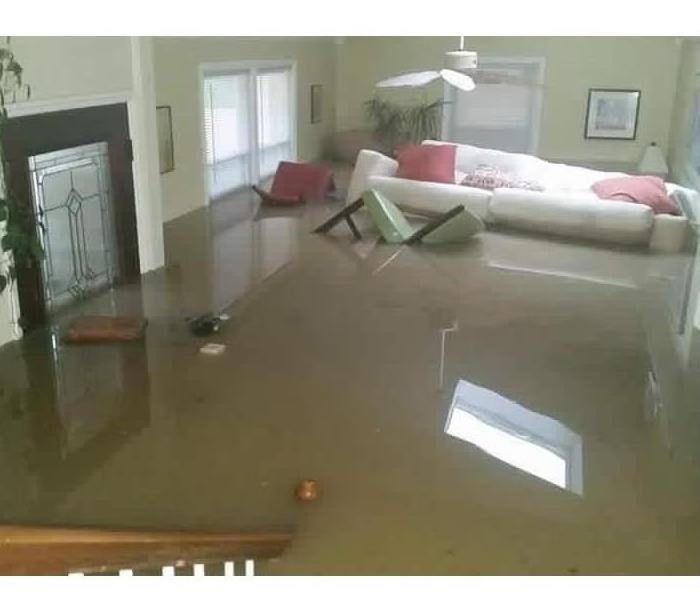 Call SERVPRO of Benton & Linn County at 541-745-2097
Call SERVPRO of Benton & Linn County at 541-745-2097
When flooding affects your home our technicians may perform a technique called a "flood cut".
This specific technique requires cutting out sections of drywall about two feet above the flood line to inspect the wall behind it. While this process is not always necessary, there are a few circumstances that may require it after a flood occurs, or in areas that have been affected for a longer period of time.
1. Black Water Floods - (Category 3)
When outdoor flooding invades your home from overflowing streams or rivers, it may contain sewage, chemicals or dead animal carcasses. This water can be considered contaminated and is known as black water or - (Category 3). A flood cut is usually necessary when this type of flooding occurs because your home’s drywall and any insulation behind it may be affected by the dirty water and will need replacing.
2. Wet Insulation
Flood technicians may perform a flood cut and tear out sections of drywall if they believe any insulation behind your home’s walls has water damage. Because once insulation is wet, it can loose its R value, and some cases depending on the insulation, it can be harder to dry.
3. Mold Growth
After flooding, mold can begin to grow behind interior walls and spread quickly if it is not addressed. Flood technicians may perform a flood cut to check for mold and treat the area if any is found. Because mold does not need sunlight to grow, it can spread from interior walls to other areas and cause an unpleasant odor in your home. A flood cut can prevent this and keep mold at bay.
Conserving water and why it is important.
3/23/2020 (Permalink)
Conservation can come in many forms. Water is a very important resource to us and we have to be sure to turn off faucets and conserve water when we are able to. Here are some tips for your family and children to follow when it comes to conserving water from SERVPRO of Benton County.
When it comes to water conservation, making the matter apparent to your children will have many benefits. It will begin to teach them the value and practices of conservation early on in their lives, a lesson that will hopefully stick for long into the future. Kids are sponges – chances are if you teach your child a way to save water in an interesting way, he or she will relay the message to classmates or friends.
Turning off the tap: minimize water use in the shower by turning off the shower head while shampooing and conditioning. Depending on where they live, this practice alone could save the average family up to $100 and 3,200 gallons of water per year (*based on a family of 3).
Sometimes you or your kids will pour more water than they wind up drinking. Instead of dumping this water down the drain, use it to water your plants, pour it into your pet’s water bowl, into your teapot or another practical use that will eliminate having to use the faucet. The same goes for ice cubes left at the end of your water glass.
Avoiding toys that require a constant stream of water as opposed to those that you fill can make a major difference when it comes to water usage. If it’s just too hot, limiting their time playing in the sprinkler can keep tabs on the situation. Also reminding your children to not play in the running water faucets and keep water use to just the needed usages.
Once you start conserving, expose your children to the struggles for clean water around the world. What they’re doing at home may translate into wanting to do more to help others.
Ways to prevent MOLD in your home.
3/20/2020 (Permalink)
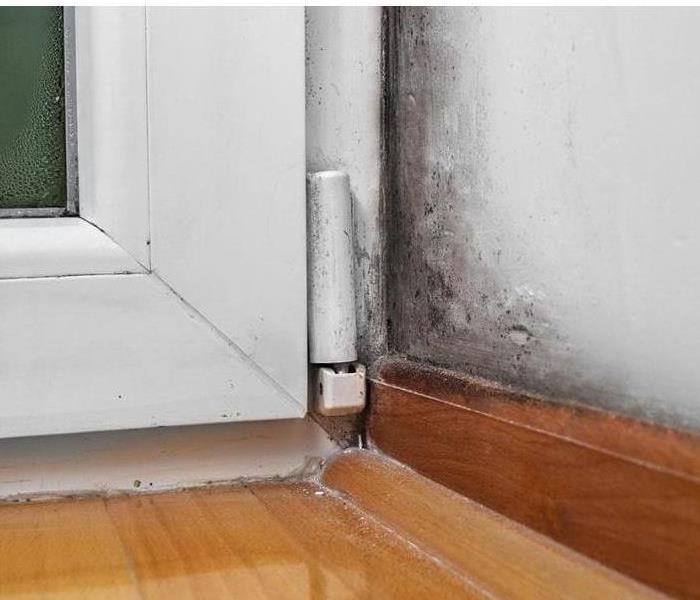 This picture shows mold growth in a corner of a wall where it meets with a out side door.
This picture shows mold growth in a corner of a wall where it meets with a out side door.
Here are some ways to keep your home safe from mold damages and prevent further damage. Brought to you by SERVPRO of Benton and Linn County.
- Eliminate Clutter
Clutter blocks airflow and prevents your HVAC system from circulating air. Furniture and curtains that block supply grilles cause condensation. All this moisture creates microclimates in your home that welcome mold growth. Push furniture away from vents and grilles to keep air circulating. On humid, still days, run a couple of fans to keep air moving.
- Shut Windows and Doors When AC Is On
When you open windows and doors, you let air conditioning escape, waste money, and invite humid air into your cooler home. This causes condensation, which mold loves. So keep doors and windows shut when the AC is humming. Also, maintain your home at around 80 degrees when you’re on vacation or at work. Too often, we bump the thermostat up to 85 degrees, or turn off the AC when we’re away. This raises temperature and humidity, which creates the ideal home for mold.
- Monitor Humidity
An indoor humidity monitor will help you keep track of moisture levels that, ideally, fall between 35% and 50% relative humidity; in very humid climates, at the height of summer, you may have to live with readings closer to 55%. But if you reach 60% relative humidity, it’s time to look for the source of the added moisture; above 70% relative humidity, certain species of mold can begin growing.
4. Water Damage
If left untreated can cause major damage in your home including serious Mold Growth.
water damage whether it is a clean water break, a leaking washing machine, or a sewage leak, it is still very important to address it quickly before further damage occurs. SERVPRO is equipped to handle whatever the situation, whether large or small.
Permanent damage happens quickly, from wood surfaces deteriorating, carpet delaminating, or mold beginning to appear because of the moist conditions. This is why it is so important to act quickly.
If your home is experiencing Mold give SERVPRO of Benton and Linn County a call today at (541)745-2097
What can cause Water Damage in your home?
3/10/2020 (Permalink)
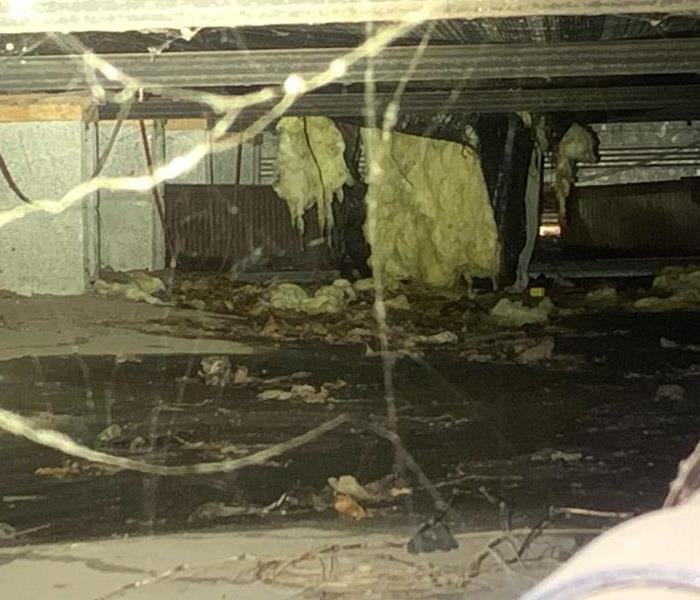 Water Damage can happen all over your home, and even underneath it.
Water Damage can happen all over your home, and even underneath it.
A Leaky Basement
One of the most common causes of water damage is a leaky basement. To make repairs, you have to find the leak. We can help address this problem
Leaky Plumbing
Another cause of water damage is a leaky plumbing system. Unless the system is plagued by multiple leaks, you can do the repair yourself. Depending on the extensiveness of the damage, you can either patch up the leaky pipe or change one or several damaged pipes if the problem is internal. SERVPRO can always help you with water damage repair that is out of your hands.
Fixing the Plant Root System
Did you know that plant and shrub overgrowth could cause water damage to the home too? When the root system of the plant and shrub is too close to a structure, water could penetrate its foundation. You can resolve minor water damage caused by plant overgrowth by trimming the shrubs and removing water that pools near the foundation of your home.
Damaged Drywall
For ceilings, the usual culprit is a leaky roof or a leaky toilet. For leaky toilets, we highly recommend getting a Plumber to stop the leak. Then let the Professionals at SERVPRO repair any damages that may have occurred. We can repair drywall, dry any moisture and help protect against mold.
Call SERVPRO today if your home or business is experiencing Water Damage our number is (541)745-2097.
What can cause water damage in your home or business
1/22/2020 (Permalink)
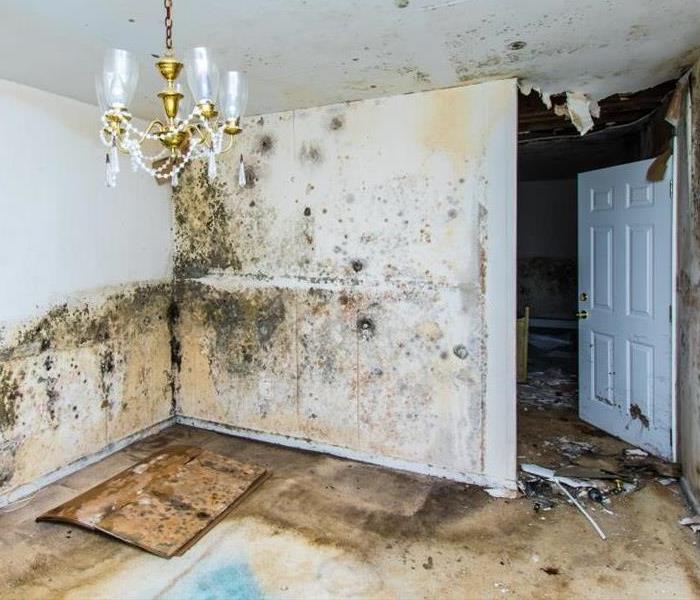 Why you should you act fast when you are experiencing water damage.
Why you should you act fast when you are experiencing water damage.
A Leaky Basement
One of the most common causes of water damage is a leaky basement. To make repairs, you have to find the leak. We can help address this problem
Leaky Plumbing
Another cause of water damage is a leaky plumbing system. Unless the system is plagued by multiple leaks, you can do the repair yourself. Depending on the extensiveness of the damage, you can either patch up the leaky pipe or change one or several damaged pipes if the problem is internal. SERVPRO can always help you with water damage repair that is out of your hands.
Fixing the Plant Root System
Did you know that plant and shrub overgrowth could cause water damage to the home too? When the root system of the plant and shrub is too close to a structure, water could penetrate its foundation. You can resolve minor water damage caused by plant overgrowth by trimming the shrubs and removing water that pools near the foundation of your home.
Damaged Drywall
For ceilings, the usual culprit is a leaky roof or a leaky toilet. For leaky toilets, we highly recommend getting a Plumber to stop the leak. Then let the Professionals at SERVPRO repair any damages that may have occurred. We can repair drywall, dry any moisture and help protect against mold.
We take all the precautions to make sure we repair the damage the right way and keep your family safe from mold and other issues caused by water damage. Call SERVPRO today at(541)745-2097.
Your house or business is damaged by water…….What do you do?
9/12/2019 (Permalink)
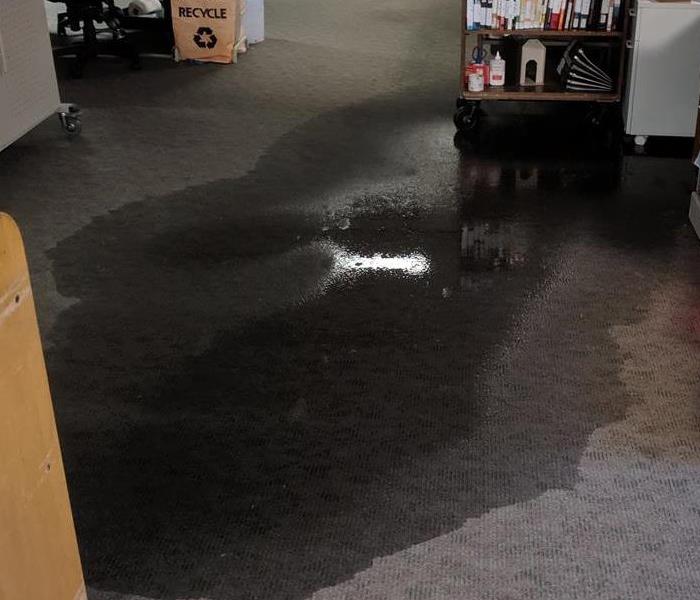 Damage to the carpets and furniture.
Damage to the carpets and furniture.
Your house is damaged by water…….What do you do?
It is vital to act quickly, before more damage occurs. First you must stop the water source or intrusion. Once stopped, mitigating, or keeping more damage from happening, is where service professionals like SERVPRO of Benton County and SERVPRO of Linn County come in. SERVPRO can come out to your house, assess the damage, clean and dry the area affected, and restore it “Like it Never Even Happened.”
Professionals, like SERVPRO of Benton County and SERVPRO of Linn County can identify water damage in obvious areas, classify the type of water doing the damage, and put together a plan of action to mitigate and restore the affected area. In addition, restoration professionals find areas unseen that have been affected and create access, or use professionally designed equipment, that allows the drying and restoration process to occur.
Whatever type of water damage you may have, whether it is a clean water break, a leaking washing machine, or a sewage leak, it is still very important to address it quickly before further damage occurs. SERVPRO is equipped to handle whatever the situation, whether large or small.
Permanent damage happens quickly, from wood surfaces deteriorating, carpet delaminating, or mold beginning to appear because of the moist conditions. This is why it is so important to act quickly.
While you are waiting for your restoration professional to arrive, here’s a few things you can do:
- Shut off the source of water if possible or contact a qualified party to stop the water source.
- Turn off circuit breakers for wet areas of the building, when access to the power distribution panel is safe from electrical shock.
- Remove as much excess water as possible by mopping and blotting.
- Remove any newspapers, magazines or colored material that may bleed onto carpets.
- Wipe excess water from wood furniture after removing lamps and tabletop items.
- Remove to a safe, dry place any paintings, art objects, computers, documents and other materials that are valuable or sensitive to moisture. .
To prevent future water damage it’s a good idea to make sure that you regularly maintain your plumbing and roofing. In your bathroom and other rooms you should make certain that you have good ventilation and you should use good insulation in your windows and walls – especially your basement. Make sure as well to clean your gutters regularly and to make sure that there is no overspill. If you are buying a new home, make sure to research the area first to avoid houses on flood plains.
You can also prepare for potential water damage by making sure you keep your most important belongings up high and away from basement level. You should also make sure you have the number of a 24-hour emergency water damage restoration service, like SERVPRO of Benton County and SERVPRO of Linn County, in your phone at all times, and you should have good insurance coverage for your home, and for your possessions to cover the restoration services and items that needs may need replacing.
Be ready in case of emergency, but if and when one occurs, rely on the professionals at SERVPRO of Benton County and SERVPRO of Linn County
If you have any questions please call 541-745-2097
Top 3 Ways to Prevent Mold in Your Home
5/21/2019 (Permalink)
Here are 7 ways to keep your home safe from mold damages and prevent further damage. Brought to you by SERVPRO.
- Eliminate Clutter
Clutter blocks airflow and prevents your HVAC system from circulating air. Furniture and curtains that block supply grilles cause condensation. All this moisture creates microclimates in your home that welcome mold growth. Push furniture away from vents and grilles to keep air circulating. On humid, still days, run a couple of fans to keep air moving.
- Shut Windows and Doors When AC Is On
When you open windows and doors, you let air conditioning escape, waste money, and invite humid air into your cooler home. This causes condensation, which mold loves. So keep doors and windows shut when the AC is humming. Also, maintain your home at around 80 degrees when you’re on vacation or at work. Too often, we bump the thermostat up to 85 degrees, or turn off the AC when we’re away. This raises temperature and humidity, which creates the ideal home for mold.
- Monitor Humidity
An indoor humidity monitor will help you keep track of moisture levels that, ideally, fall between 35% and 50% relative humidity; in very humid climates, at the height of summer, you may have to live with readings closer to 55%. But if you reach 60% relative humidity, it’s time to look for the source of the added moisture; above 70% relative humidity, certain species of mold can begin growing.
How to Conserve Water
3/28/2019 (Permalink)
Conservation can come in many forms. Water is a very important resource to us and we have to be sure to turn off faucets and conserve water when we are able to. Here are some tips for your family and children to follow when it comes to conserving water from SERVPRO of Benton County.
When it comes to water conservation, making the matter apparent to your children will have many benefits. It will begin to teach them the value and practices of conservation early on in their lives, a lesson that will hopefully stick for long into the future. Kids are sponges – chances are if you teach your child a way to save water in an interesting way, he or she will relay the message to classmates or friends.
Turning off the tap: minimize water use in the shower by turning off the shower head while shampooing and conditioning. Depending on where they live, this practice alone could save the average family up to $100 and 3,200 gallons of water per year (*based on a family of 3).
Sometimes you or your kids will pour more water than they wind up drinking. Instead of dumping this water down the drain, use it to water your plants, pour it into your pet’s water bowl, into your teapot or another practical use that will eliminate having to use the faucet. The same goes for ice cubes left at the end of your water glass.
Avoiding toys that require a constant stream of water as opposed to those that you fill can make a major difference when it comes to water usage. If it’s just too hot, limiting their time playing in the sprinkler can keep tabs on the situation. Also reminding your children to not play in the running water faucets and keep water use to just the needed usages.
Once you start conserving, expose your children to the struggles for clean water around the world. What they’re doing at home may translate into wanting to do more to help others.
The Appliances in your home that can cause water damage !
3/28/2019 (Permalink)
Water damage can happen from many different appliances in your home. Here are some tips from SERVPRO of Benton County on how to make sure your appliances are working properly and the water supply lines are in good condition. As a good rule of thumb, check behind your appliances once per year. This is a good way to address problems before they happen.
Washers
Small leaks stemming from a washing machine may appear to be a minor issue, but the problem should not be ignored. Even a pinhole leak in a water supply line can subsequently break out into a household flood. In fact, a burst supply line is a key cause of significant water damage involving washers. A good way to prevent water damage is to check your hoses leading to your washing machine a couple times per year.
Also consider installing an automatic shutoff valve. When water pools on the floor, the sensor detects it and closes the water valve.
Refrigerators with Ice Makers Hooked up to plumbing
We appreciate the convenience of an automatic ice maker, but it can also be the culprit of household floods. The copper or plastic water line that supplies an ice maker can leak or worse yet, become unattached if it’s not installed properly. Again, you should inspect the line periodically for crimps and make sure the valve connection is secure. Leaving a four inch gap between the refrigerator and wall also helps to prevent crimping in your water line.
Dish Washers
Dishwashers are another common appliance that can cause problems. If a dishwasher has a supply line burst it can fill your kitchen with water during a wash and rinse cycle.
Another source of household floods is when a dishwasher backs up soaking the floor with sudsy water. The problem could be the wrong detergent, a faulty float, the buildup of food and other debris in the drain gate or a clog in the discharge hose under the sink.
Routine inspection of the hoses and connections can save you major repair costs in the future. In addition, check the drain gate frequently and remove food particles and debris.
Your house is damaged by water…….What do you do?
3/15/2019 (Permalink)
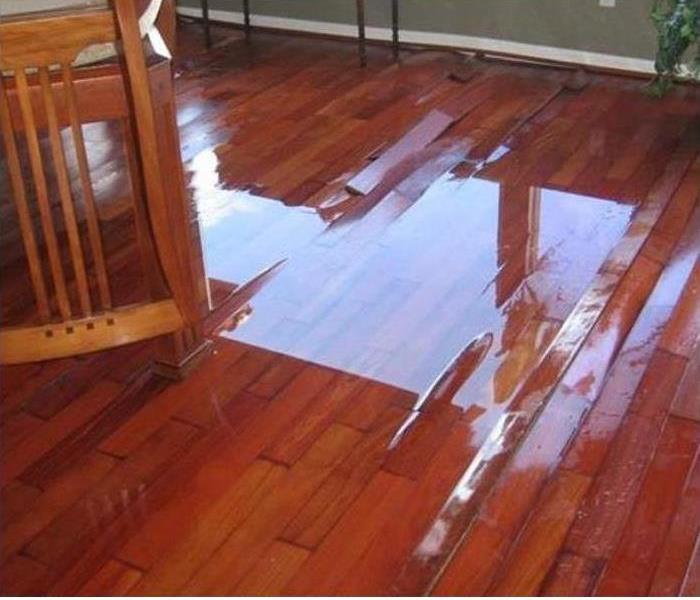 Water can be extremely damaging to your home.
Water can be extremely damaging to your home.
It is vital to act quickly, before more damage occurs. First you must stop the water source or intrusion. Once stopped, mitigating, or keeping more damage from happening, is where service professionals like SERVPRO of Benton County. SERVPRO can come out to your house, assess the damage, clean and dry the area affected, and restored.
Professionals, like SERVPRO of Benton County can identify water damage in obvious areas, classify the type of water doing the damage, and put together a plan of action to mitigate and restore the affected area. In addition, restoration professionals find areas unseen that have been affected and create access, or use professionally designed equipment, that allows the drying and restoration process to occur.
Whatever type of water damage you may have, whether it is a clean water break, a leaking washing machine, or a sewage leak, it is still very important to address it quickly before further damage occurs. SERVPRO is equipped to handle whatever the situation, whether large or small.
Permanent damage happens quickly, from wood surfaces deteriorating, carpet de-laminating, or mold beginning to appear because of the moist conditions. This is why it is so important to act quickly.
While you are waiting for your restoration professional to arrive, here’s a few things you can do:
- Shut off the source of water if possible or contact a qualified party to stop the water source.
- Turn off circuit breakers for wet areas of the building, when access to the power distribution panel is safe from electrical shock.
- Remove as much excess water as possible by mopping and blotting.
- Remove any newspapers, magazines or colored material that may bleed onto carpets.
- Wipe excess water from wood furniture after removing lamps and tabletop items.
- Remove to a safe, dry place any paintings, art objects, computers, documents and other materials that are valuable or sensitive to moisture. .
To prevent future water damage it’s a good idea to make sure that you regularly maintain your plumbing and roofing. In your bathroom and other rooms you should make certain that you have good ventilation and you should use good insulation in your windows and walls – especially your basement. Make sure as well to clean your gutters regularly and to make sure that there is no overspill. If you are buying a new home, make sure to research the area first to avoid houses on flood plains.
You can also prepare for potential water damage by making sure you keep your most important belongings up high and away from basement level. You should also make sure you have the number of a 24-hour emergency water damage restoration service, like SERVPRO of Benton County, in your phone at all times and you should have good insurance coverage for your home and for your possessions to cover the restoration services and items that needs may need replacing.
Be ready in case of emergency, but if and when one occurs, rely on the professionals at SERVPRO of Benton County.
If you have any questions please call 541-745-2097
Why you need to keep an eye under your kitchen sink…
1/22/2019 (Permalink)
No matter what time of year it seems like kitchen sink pipes like to leek. WE at SERVPRO of Benton County get many calls about leeks from kitchen sink pipes. One of the new jobs we received was a kitchen sink pipe leaking, and the home owner was not aware of the leek until it leaked in to their daylight basement and ruined the insulation, and ceiling dry wall. The leek also caused damaged to the carpet, and carpet pad in the effected area. Here are some helpful tips to keep in mind to avoid this situation .
1. Make sure you check once month under you sink for leeks.
2. Don't keep a lot of stuff under the sink, so it hard to notice if a leek is happening.
3. Line your cupboard with cupboard liner, so that it can protect from moister.
4. When the weather is below freezing leave you cupboard open it bit to get heat.
5. Do moister checks also once a month to make sure the wood/plywood is not wet.
If you run in to a kitchen sink leak that has cause damage SERVPRO can help. All you need to do is call.
Water
9/19/2018 (Permalink)
October fog is coming a little early this year.... that means more wet weather!
Many old homes within our great Willamette Valley are historic and lack many of the protective features that many new construction homes have.
New construction has treated wood, insulation, and barriers, that prevent mold and water damage; in older homes, however, many lack these great features and thus more are adept to water damage.
Basements especially! In older and newer homes, basements flood. Pipes run above the basement and can brake in frozen conditions, which then lead to flooding.
According to Waterdamagedefense.com, 98% of basements experience some sort of water damage in its lifespan.
In addition, 14,000 people in the U.S. experience some sort of water damage emergency each day. That's a lot!
The good news is, SERVPRO of Linn and Benton county has all the equipment and expertise to fix any water damage situation. Our crews are trained to handle whatever the situation is.
As a franchise, we also follow the "1-4-8" rule.
-Within 1 hour we are in contact with the customer.
- Within 4 hours mitigation has begun.
- Within 8 hours we are speaking with the adjuster about your situation.
Following these steps makes the secondary halt, and help, we make it "Like it never even happened".
Common Causes of Water Damage
5/7/2018 (Permalink)
 Quickly stopping and addressing water leaks can help prevent greater damage.
Quickly stopping and addressing water leaks can help prevent greater damage.
A Leaky Basement
One of the most common causes of water damage is a leaky basement. To make repairs, you have to find the leak. We can help address this problem
Leaky Plumbing
Another cause of water damage is a leaky plumbing system. Unless the system is plagued by multiple leaks, you can do the repair yourself. Depending on the extensiveness of the damage, you can either patch up the leaky pipe or change one or several damaged pipes if the problem is internal. SERVPRO can always help you with water damage repair that is out of your hands.
Fixing the Plant Root System
Did you know that plant and shrub overgrowth could cause water damage to the home too? When the root system of the plant and shrub is too close to a structure, water could penetrate its foundation. You can resolve minor water damage caused by plant overgrowth by trimming the shrubs and removing water that pools near the foundation of your home.
Damaged Drywall
For ceilings, the usual culprit is a leaky roof or a leaky toilet. For leaky toilets, we highly recommend getting a Plumber to stop the leak. Then let the Professionals at SERVPRO repair any damages that may have occurred. We can repair drywall, dry any moisture and help protect against mold.
SERVPRO can help make your water damages ""Like it never even happened". We take all the precautions to make sure we repair the damage the right way and keep your family safe from mold and other issues caused by water damage.
Hidden dangers of flooding
3/31/2018 (Permalink)
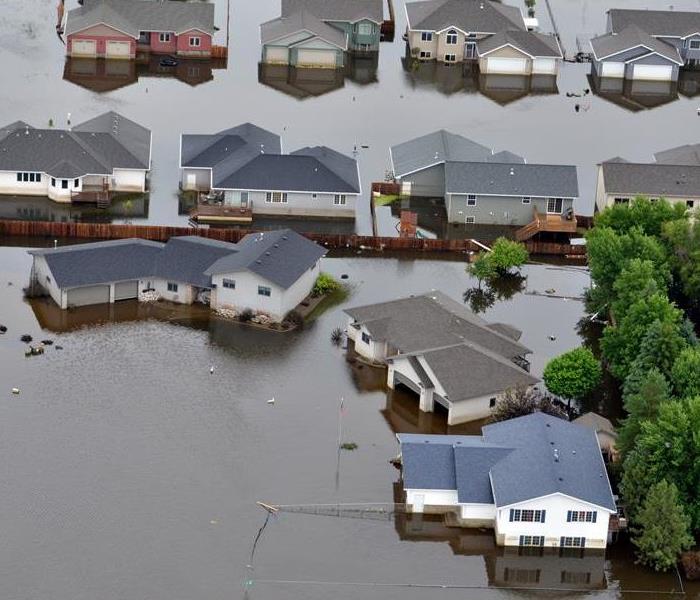 Standing water inside your home can pose health risks.
Standing water inside your home can pose health risks.
Storms can bring rain and flooding. Would you know how to protect your family in the event of a flood? Did you realize that in addition to structural damage, a flood can pose a health risk to your family, as well? Being aware of a few simple things can help reduce the risk to you and your family.
Evacuate if instructed to do so. Do not try to wait out the flood in your home if you are advised to evacuate.
Floodwaters often contain sewage and toxins, especially in Urban areas. Avoid contact with the water.
Standing water is a breeding ground for bacteria, viruses and mold. These can become airborne, and pose a health risk if inhaled.
Identify vulnerable populations – such as elderly, children, immunocompromised, those with asthma, or any other airway diseases, and keep them from the flood waters until area has been dried.
Turn off gas and electric before entering a dwelling that has standing water.
Make sure any workers assisting in clean up wear protective gear, this includes gloves and goggles to prevent exposure to harmful substances.
When in doubt, toss it out – damp buildings and furnishings promote the growth of bacteria, dust mites, and mold. Anything that cannot be cleaned and dried must be discarded.
CALL YOUR Storm and Water Restoration Specialists at SERVPRO! Our professionals are experienced in Storm and Water Clean-ups and Restoration. We are ready to help, and have to tools to safely get the job done. Call us today!
Faster to Benton County Water Damage Event
3/31/2018 (Permalink)
 In the event of a flood, call on your SERVPRO Professionals to help!
In the event of a flood, call on your SERVPRO Professionals to help!
Faster To Any Size Disaster
Flooding and water damage is very invasive. Water quickly spreads throughout your home and gets absorbed into floors, walls, furniture, and more. SERVPRO of Benton County arrives quickly and starts the water extraction process almost immediately. This immediate response helps to minimize the damage and the cleaning and restoration costs.
Need Emergency Service? Call Us 24/7 –541-745-2097
Water Damage Timeline
Within Minutes
- Water quickly spreads throughout your property, saturating everything in its path.
- Water is absorbed into walls, floors, upholstery, and belongings.
- Furniture finishes may bleed, causing permanent staining on carpets.
- Photographs, books, and other paper goods start to swell and warp.
Hours 1 - 24:
- Drywall begins to swell and break down.
- Metal surfaces begin to tarnish.
- Furniture begins to swell and crack.
- Dyes and inks from cloth and paper goods spread and stain.
- A musty odor appears.
48 Hours to 1 Week:
- Mold and mildew may grow and spread.
- Doors, windows, and studs swell and warp.
- Metal begins to rust and corrode.
- Furniture warps and shows signs of mold.
- Paint begins to blister.
- Wood flooring swells and warps.
- Serious biohazard contamination is possible.
More Than 1 Week:
- Restoration time and cost increase dramatically; replacing contaminated materials and structural rebuilding may be extensive.
- Structural safety, mold growth, and biohazard contaminants pose serious risks to occupants.
About SERVPRO of Benton County
SERVPRO of Benton County specializes in the cleanup and restoration of residential and commercial property after a fire, smoke or water damage event. Our staff is highly trained in property damage restoration. From initial and ongoing training at SERVPRO’s corporate training facility to regular IICRC-industry certification, rest assured our staff is equipped with the knowledge to restore your property.
Design Tips to Protect Your Basement Floor Against Water Damage
3/31/2018 (Permalink)
 Epoxy flooring is ideal for basements. Not only can it be beautiful, it is naturally water-proof.
Epoxy flooring is ideal for basements. Not only can it be beautiful, it is naturally water-proof.
Finding a home with a basement here in Oregon is almost as rare as seeing Sasquatch. When we do find a basement, our excitement is hard to contain as the possibilities are endless! This extra square footage could be ideal for storage, a guest bedroom, a playroom for the kids/grandkids, a den, a room for entertaining…..the list goes on and on. But before we make any final decisions on what to do with this extra space, we must keep one thing in mind: basements are rare here because our ground gets very wet. Wet ground can lead to water leaking into you home. While there are steps you can take to help prevent water from gaining access to your basement, there are also a few simple flooring ideas that can help minimize damage IF water ever did get into your home.
AVOID CARPETING It may seem appealing to have a softer floor covering if you plan to turn this space into a cozy room for relaxing, or a playroom for children. But, unfortunately, carpeting and its padding soak up any moisture that may come into your home, and can become a breeding ground for mold.
Epoxy Coating a concrete basement subfloor with epoxy will make it waterproof and durable. Available in a variety of colors, epoxies can easily be applied over a weekend.
Concrete stain Stain can dress up concrete floors with very little cost an effort. Unlike some other types of concrete coatings, stain is resistant to chipping or flaking. Stains also come in a wide variety of colors, making it easy to match your décor.
Ceramic Tile Affordable and timeless, ceramic tile can easily be applied directly over a concrete slab. Tile is also resistant to water and humidity, making it a good choice for basement flooring.
Painted Concrete Paint is easy and the least expensive solution. Do your research, and be sure to get a latex based paint that is resistant to humidity and cooler temperatures. Use a roller to apply at least 2 coats directly to the floor. You may have to touch up the floor every few years.
You can always accessorize for comfort by using area rugs. These not only look nice, but can easily be replaced if any water damage does occur. If you ever do find yourself with water damage in your basement, do not hesitate to call your Water Restoration Specialists at SERVPRO. We are on-call 24/7 and ready to help you get back to enjoying your basement.
Prevent Water Damage
2/19/2018 (Permalink)
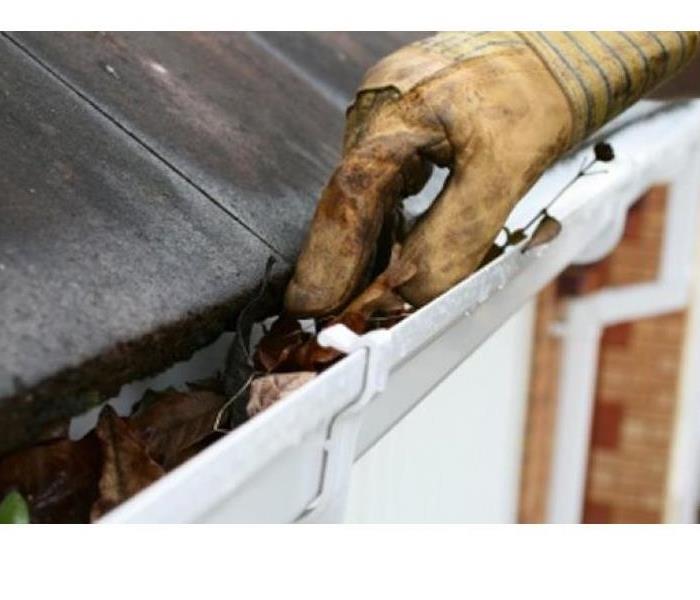 Cleaning your gutters regularly can prevent water damage to your home.
Cleaning your gutters regularly can prevent water damage to your home.
It might not seem like a big deal, but it is very important to clean out your gutters. Professionals recommend doing it at least twice per year. Gutters allow water to safely flow from your roof and away from your home for proper drainage. When you gutters become clogged with leaves, twigs and other debris, this can cause clogging of the down spouts. Water that gets dammed up in the gutters will find the path of least resistance as it tries to drain…and this often means it feeds back into the walls and ceilings of your home.
Water working its way into your home can lead to a host of problems. The moisture can create the perfect breeding ground for mold growth in your walls or attic. Water can cause rotting of your ceilings or drywall. If gone unnoticed, rot can even settle into the wooden frames of your home and cause structural integrity problems.
Another way clogged gutters can allow the water to damage your home is the debris dams allows the water to flow over the rim of the gutter and wash down the side of your home. This can cause damage to paint or siding, and eventually allowing water to get inside your walls and wreak havoc, unseen.
Did you know that even flooded basements and cracked foundations can be a symptom of clogged gutters? If water cannot drain away from the house properly, it can pool around the foundation. This water then expands when frozen, which can cause cracking to your foundation, which allows even MORE water into your basement
Water can be a destructive force to your home. And here in the Willamette Valley, we sure do see a lot of rain. Do your best to protect your home from water damage. One of the easiest steps is to keep your gutters clean.
But if you do find water damage in your home, do not hesitate to call your team of Water Restoration Specialists at SERVPRO today!
Protecting your home from common water damage
9/26/2017 (Permalink)
 Protect your home from water damages caused by common household appliances
Protect your home from water damages caused by common household appliances
Water damage can happen from many different appliances in your home. Here are some tips from SERVPRO of Linn County on how to make sure your appliances are working properly and the water supply lines are in good condition. As a good rule of thumb, check behind your appliances once per year. This is a good way to address problems before they happen.
Washers
Small leaks stemming from a washing machine may appear to be a minor issue, but the problem should not be ignored. Even a pinhole leak in a water supply line can subsequently break out into a household flood. In fact, a burst supply line is a key cause of significant water damage involving washers. A good way to prevent water damage is to check your hoses leading to your washing machine a couple times per year.
Also consider installing an automatic shutoff valve. When water pools on the floor, the sensor detects it and closes the water valve.
Refrigerators with Ice Makers Hooked up to plumbing
We appreciate the convenience of an automatic ice maker, but it can also be the culprit of household floods. The copper or plastic water line that supplies an ice maker can leak or worse yet, become unattached if it’s not installed properly. Again, you should inspect the line periodically for crimps and make sure the valve connection is secure. Leaving a four inch gap between the refrigerator and wall also helps to prevent crimping in your water line.
Dish Washers
Dishwashers are another common appliance that can cause problems. If a dishwasher has a supply line burst it can fill your kitchen with water during a wash and rinse cycle.
Another source of household floods is when a dishwasher backs up soaking the floor with sudsy water. The problem could be the wrong detergent, a faulty float, the buildup of food and other debris in the drain gate or a clog in the discharge hose under the sink.
Routine inspection of the hoses and connections can save you major repair costs in the future. In addition, check the drain gate frequently and remove food particles and debris.
Water Damage from City Water Main Break
9/25/2017 (Permalink)
 Water damage can be a huge expense in your home. Here are some ways that water damage affects your home and what you can do about it.
Water damage can be a huge expense in your home. Here are some ways that water damage affects your home and what you can do about it.
Usually a sign that a water main has broken is a loss in pressure. If you are experiencing a loss in water pressure, have SERVPRO of Benton County
Overly dry or wet weather causes the ground to shift, typically resulting in round breaks wrapping around the diameter of the pipe. Sudden pressure fluctuations and the normal aging process of the mains also cause breaks, typically resulting in lateral breaks running along the pipe.
If the problem is simply a pipe blockage, you are likely to notice reduced pressure and/or volume when you turn on the shower or faucet in your home. A water main break will result in water leakage, which can turn your front yard into a swamp. You might also detect an unpleasant odor. A good clue that you could possibly have a leak somewhere in the system is an inexplicable increase in your water bill.
After you get your pipe fixed give SERVPRO a call and we will come out and fix the damage that this major break has done to your house. we can repair mold damage and water damage. We will get your home smelling and looking like new!
How to prevent frozen pipes
9/25/2017 (Permalink)
 Winter brings cold temperatures and with cold temperatures come cold and possible frozen pipes. Here are some ways to prevent that.
Winter brings cold temperatures and with cold temperatures come cold and possible frozen pipes. Here are some ways to prevent that.
Cold temperatures can cause pipes to freeze. Frozen pipes can result in costly repairs to you as a home or business owner. The good news is there are ways to prevent pipes from freezing. Here are some tips for this winter.
Frozen Pipes Can Burst
Frozen pipes are a problem by themselves, because they prevent water flow, but even worse, frozen pipes can eventually burst, causing damage and potential flooding. There are ways to protect your pipes from freezing. These include:
Keep your house warm
If you are leaving for a period of time, make sure that the heat is kept on at your property. You should inform them that the heat can help prevent pipes from freezing, and if pipes freeze and burst, it can cause a lot of water damage to the property and to their possessions. The heat doesn’t have to be kept as high as you normally would keep it if you were home but keeping it set above 50 degrees Fahrenheit at all times is a good idea. This should provide enough heat to keep the pipes warm and to prevent any water inside from freezing.
Open Faucets
When temps hit the freezing level it is a good idea to allow faucets to drip. Allowing the faucet to be open like this will relieve pressure in the pipe. If a pipe freezes, it is actually the pressure that is created between the blockage and the faucet that will cause the pipe to burst. With the faucet open you avoid blockage in the pipes.
Insulation in key
Pipes can be fitted with foam rubber or fiberglass sleeves to help decrease the chances of freezing. This can be an easy solution for pipes that are exposed, but can get expensive if walls, floors or ceilings have to be opened in order to properly insulate the pipe. Additional insulation can also be added to walls and ceilings to keep the pipes warm.
How to deal with a flood
5/8/2017 (Permalink)
After your home has suffered a water damage such as a flood it is important to get into your home and address the problem as quickly and safely as possible. SERVPRO can help you get the water damage fixed and salvage the furniture and goods that were damaged. Here are some things to look out for:
Re-entering your home
- Do not return home until authorities have advised that it is safe to do so.
- If the main power switch was not turned off prior to flooding, do not re-enter your home until a qualified electrician has determined it is safe to do so.
- Use extreme caution when returning to your home after a flood.
- The main electrical panel must be cleaned, dried, and tested by a qualified electrician to ensure that it is safe.
Ensure building safety
- Make sure the building is structurally safe.
- Look for buckled walls or floors.
- Watch for holes in the floor, broken glass and other potentially dangerous debris.
Water
- Flood water can be heavily contaminated with sewage and other pollutants. It can cause sickness and infections.
- If through colour, odour or taste you suspect that your drinking water has been contaminated, don't drink it.
- Household items that have been flood-damaged will have to be discarded according to local regulations.
Water Conservation Tips
4/21/2017 (Permalink)
 Save water and prevent water damage.
Save water and prevent water damage.
Conservation can come in many forms. Water is a very important resource to us and we have to be sure to turn off faucets and conserve water when we are able to. Here are some tips for your family and children to follow when it comes to conserving water from SERVPRO of Linn County.
When it comes to water conservation, making the matter apparent to your children will have many benefits. It will begin to teach them the value and practices of conservation early on in their lives, a lesson that will hopefully stick for long into the future. Kids are sponges – chances are if you teach your child a way to save water in an interesting way, he or she will relay the message to classmates or friends.
Turning off the tap: minimize water use in the shower by turning off the shower head while shampooing and conditioning. Depending on where they live, this practice alone could save the average family up to $100 and 3,200 gallons of water per year (*based on a family of 3).
Sometimes you or your kids will pour more water than they wind up drinking. Instead of dumping this water down the drain, use it to water your plants, pour it into your pet’s water bowl, into your teapot or another practical use that will eliminate having to use the faucet. The same goes for ice cubes left at the end of your water glass.
Avoiding toys that require a constant stream of water as opposed to those that you fill can make a major difference when it comes to water usage. If it’s just too hot, limiting their time playing in the sprinkler can keep tabs on the situation. Also reminding your children to not play in the running water faucets and keep water use to just the needed usages.
Once you start conserving, expose your children to the struggles for clean water around the world. What they’re doing at home may translate into wanting to do more to help others.
3 Ways to Prevent Mold In Your Home
4/21/2017 (Permalink)
Here are 7 ways to keep your home safe from mold damages and prevent further damage. Brought to you by SERVPRO.
- Eliminate Clutter
Clutter blocks airflow and prevents your HVAC system from circulating air. Furniture and curtains that block supply grilles cause condensation. All this moisture creates microclimates in your home that welcome mold growth. Push furniture away from vents and grilles to keep air circulating. On humid, still days, run a couple of fans to keep air moving.
- Shut Windows and Doors When AC Is On
When you open windows and doors, you let air conditioning escape, waste money, and invite humid air into your cooler home. This causes condensation, which mold loves. So keep doors and windows shut when the AC is humming. Also, maintain your home at around 80 degrees when you’re on vacation or at work. Too often, we bump the thermostat up to 85 degrees, or turn off the AC when we’re away. This raises temperature and humidity, which creates the ideal home for mold.
- Monitor Humidity
An indoor humidity monitor will help you keep track of moisture levels that, ideally, fall between 35% and 50% relative humidity; in very humid climates, at the height of summer, you may have to live with readings closer to 55%. But if you reach 60% relative humidity, it’s time to look for the source of the added moisture; above 70% relative humidity, certain species of mold can begin growing.
Water Damage Restoration
6/3/2016 (Permalink)
 Fixing water damage in your Corvallis home.
Fixing water damage in your Corvallis home.
Your house is damaged by water…….What do you do?
It is vital to act quickly, before more damage occurs. First you must stop the water source or intrusion. Once stopped, mitigating, or keeping more damage from happening, is where service professionals like SERVPRO of Benton County and SERVPRO of Linn County come in. SERVPRO can come out to your house, assess the damage, clean and dry the area affected, and restore it “Like it Never Even Happened.”
Professionals, like SERVPRO of Benton County and SERVPRO of Linn County can identify water damage in obvious areas, classify the type of water doing the damage, and put together a plan of action to mitigate and restore the affected area. In addition, restoration professionals find areas unseen that have been affected and create access, or use professionally designed equipment, that allows the drying and restoration process to occur.
Whatever type of water damage you may have, whether it is a clean water break, a leaking washing machine, or a sewage leak, it is still very important to address it quickly before further damage occurs. SERVPRO is equipped to handle whatever the situation, whether large or small.
Permanent damage happens quickly, from wood surfaces deteriorating, carpet delaminating, or mold beginning to appear because of the moist conditions. This is why it is so important to act quickly.
While you are waiting for your restoration professional to arrive, here’s a few things you can do:
1. Shut off the source of water if possible or contact a qualified party to stop the water source.
2. Turn off circuit breakers for wet areas of the building, when access to the power distribution panel is safe from electrical shock.
3. Remove as much excess water as possible by mopping and blotting.
4. Remove any newspapers, magazines or colored material that may bleed onto carpets.
5. Wipe excess water from wood furniture after removing lamps and tabletop items.
6. Remove to a safe, dry place any paintings, art objects, computers, documents and other materials that are valuable or sensitive to moisture. .
To prevent future water damage it’s a good idea to make sure that you regularly maintain your plumbing and roofing. In your bathroom and other rooms you should make certain that you have good ventilation and you should use good insulation in your windows and walls – especially your basement. Make sure as well to clean your gutters regularly and to make sure that there is no overspill. If you are buying a new home, make sure to research the area first to avoid houses on flood plains.
You can also prepare for potential water damage by making sure you keep your most important belongings up high and away from basement level. You should also make sure you have the number of a 24-hour emergency water damage restoration service, like SERVPRO of Benton County and SERVPRO of Linn County, in your phone at all times and you should have good insurance coverage for your home and for your possessions to cover the restoration services and items that needs may need replacing.
Be ready in case of emergency, but if and when one occurs, rely on the professionals at SERVPRO of Benton County and SERVPRO of Linn County to “Make it Like it Never Even Happened.”
If you have any questions please call 541-745-2097






 24/7 Emergency Service
24/7 Emergency Service






















